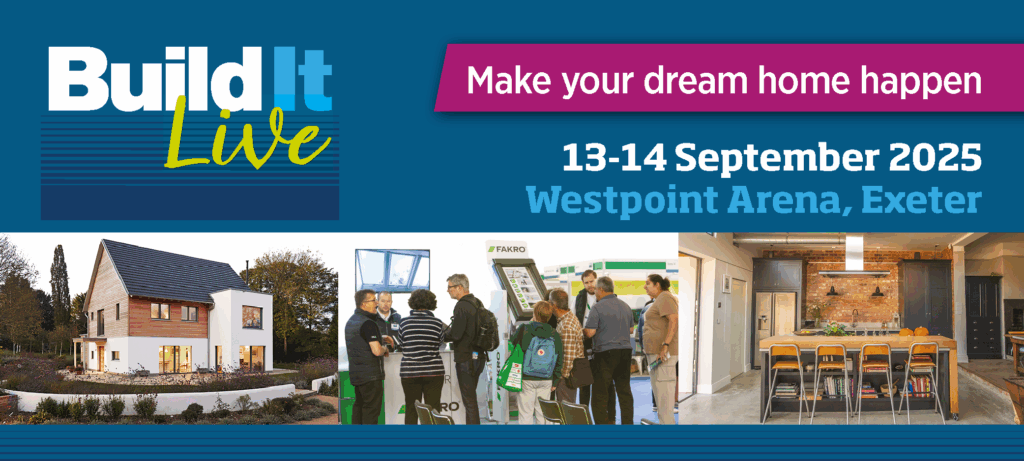
Early bird offer!
Claim your two free tickets here!
Early bird offer!
Claim your two free tickets here!Staircase ideas come in all shapes and sizes, but investing in the right design that meets your practical needs and ties in with your home’s architecture can really transform a space and how you move throughout it on a day-to-day basis.
Staircases often take pride of place in a floorplan, and in many cases, they’re the first feature you see when you walk through the front door. Not only do they have to serve a practical purpose in connecting one storey to another, but with careful planning and consideration, a staircase can become an impressive focal point that defines the overall style of your property.
When it comes to gathering staircase ideas, there are lots of options as well as a range of materials that can be mixed and matched. For example, natural stone staircase designs are extremely durable, easy to maintain and will last a long time. Timber is a versatile material , with many species and the option to stain or paint it to evolve with your home’s design. Steel is strong but can be moulded to form sturdy spiral staircase designs, and is ideal if you prefer an industrial aesthetic. Glass looks contemporary while letting in light for a bright space.
Straight, L-shaped and U-shaped staircase designs are classic designs that suit a multitude of spaces, often with the ability to incorporate extra storage underneath. If you’re looking for a more striking design, curved, spiral, cantilever and even bifurcated (where the staircase splits off into two) styles can add drama to a space, working particularly well in high-ceilinged entrance halls for a feeling of luxury.
Here, we’re taking a look at a collection of 35 excellent staircase ideas to inspire your project.
Adam Knibb Architects designed this floating staircase for a new four-bed family home, to suit the monochromatic interiors. A white painted steel box provides a central spine for the stained oak treads, while invisible glass fixings and a toughened glazed balustrade with oak handrail add to the weightless look.
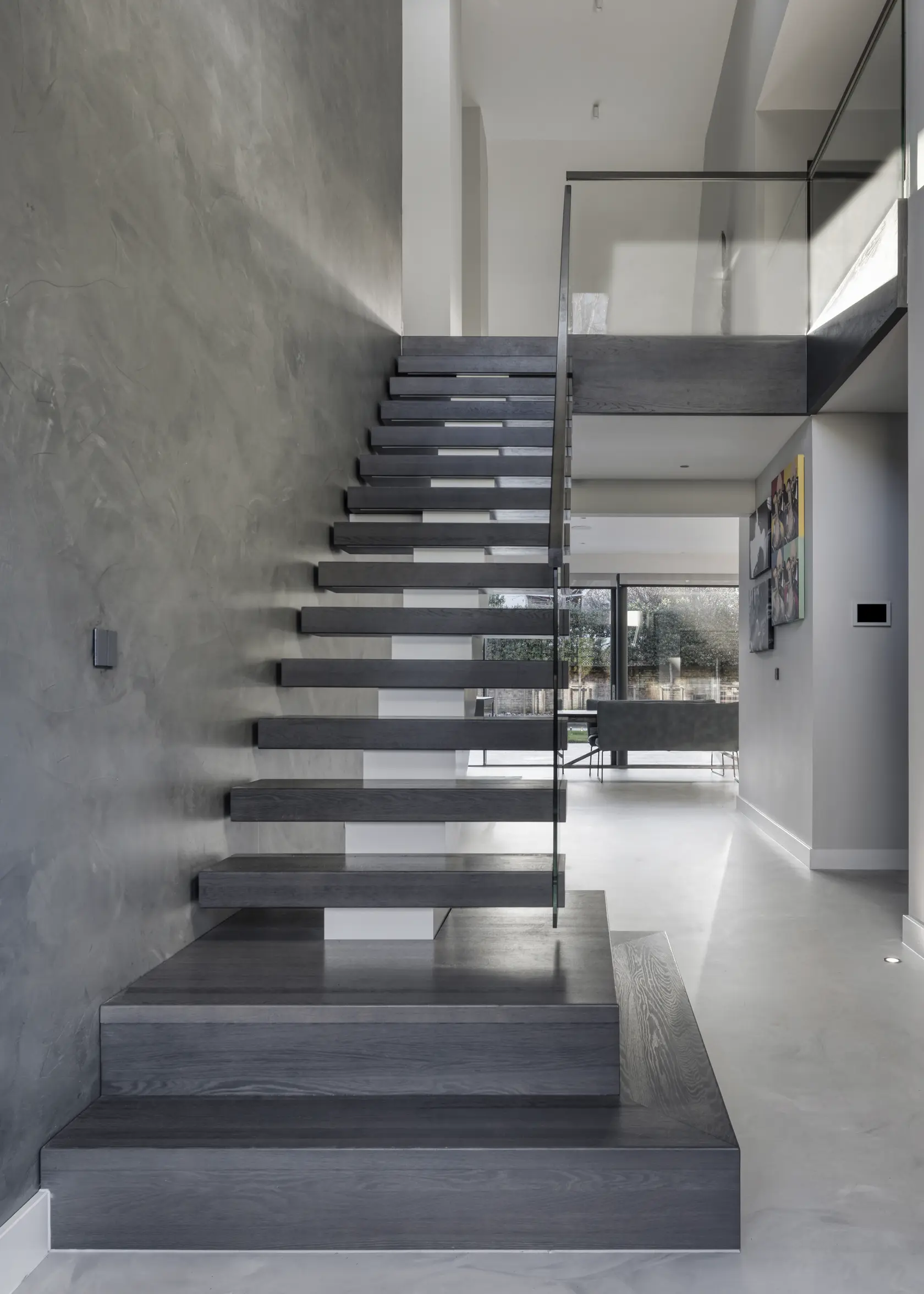
Photo: Martin Gardner
Featuring triple-laminated, low-iron glass treads supported by a curved structural glazed balustrade, this stunning design from Bisca is a sleek, contemporary solution that allows light to flow uninterrupted through the space. Made from 80% glass, only the handrail and minimal fixings are visible, allowing the steps to disappear into the view behind.
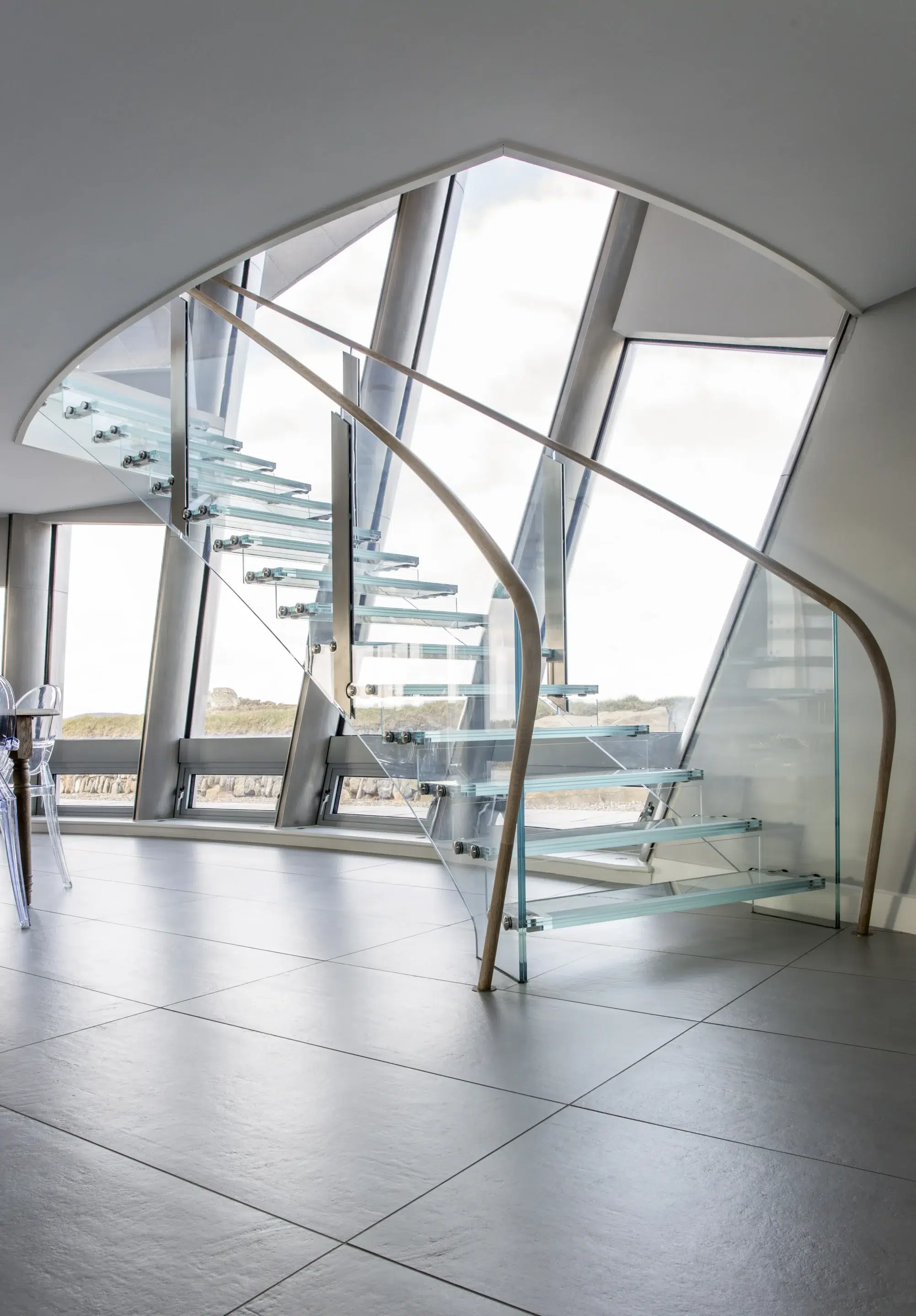
find staircase suppliers in Build It’s Directory
Designed by Gundry + Ducker, this unique cantilevered staircase is the centrepiece of this renovation and extension project. Made from a bespoke mix of terrazzo, using both in-situ and precast formats, the flight connects each floor in the impressive triple height entrance. The funky material can be found on the treads, flooring and worktops, and has even been used to clad the rear extension.
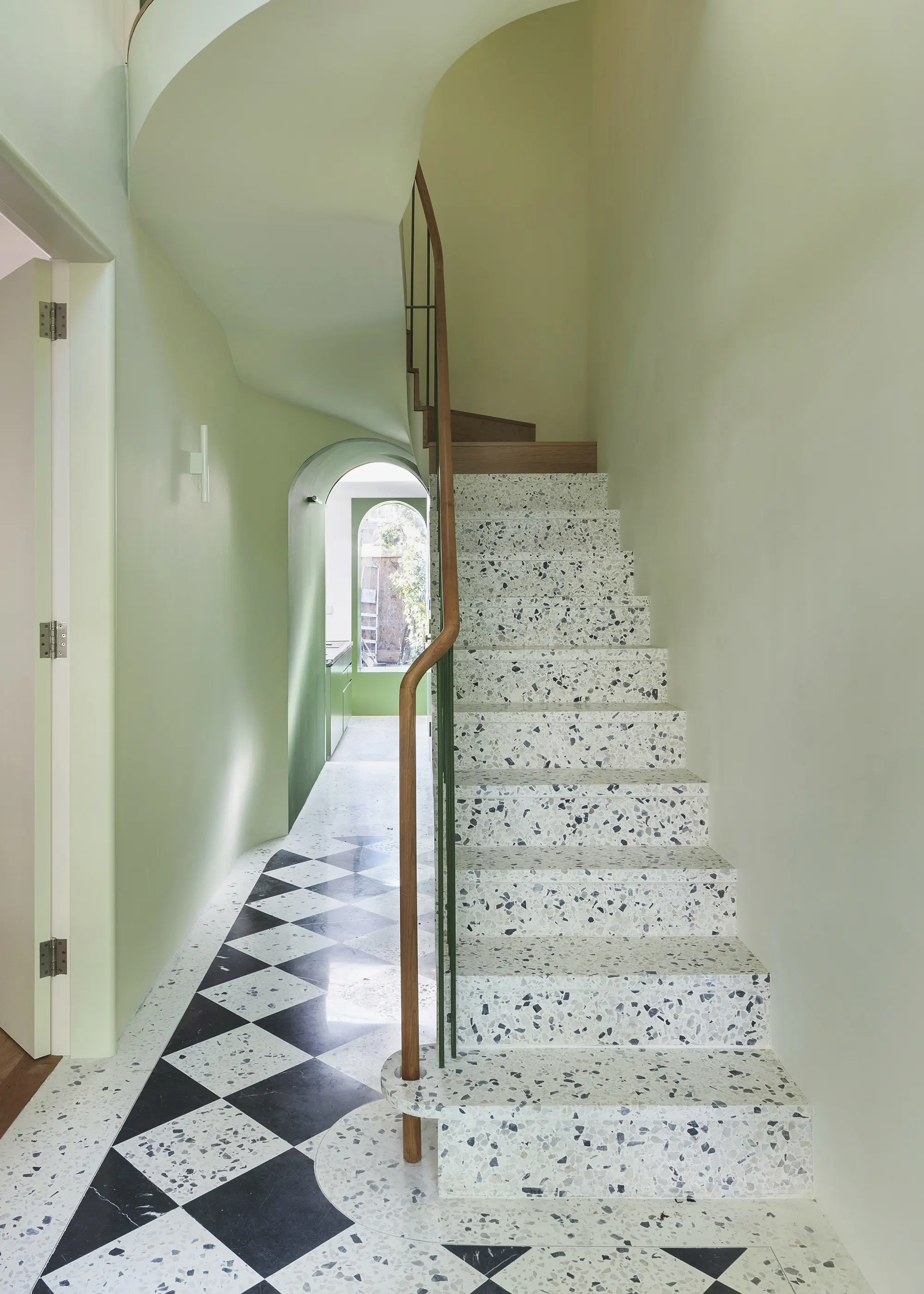
Photo: Andrew Meredith
Combining natural oak, painted components and clear glass, this modern flight by Max-Stairs sets the tone for the rest of the house – elegant but understated. The impressive sculptural design has no visible supports, adding to the sleek and stylish finish.
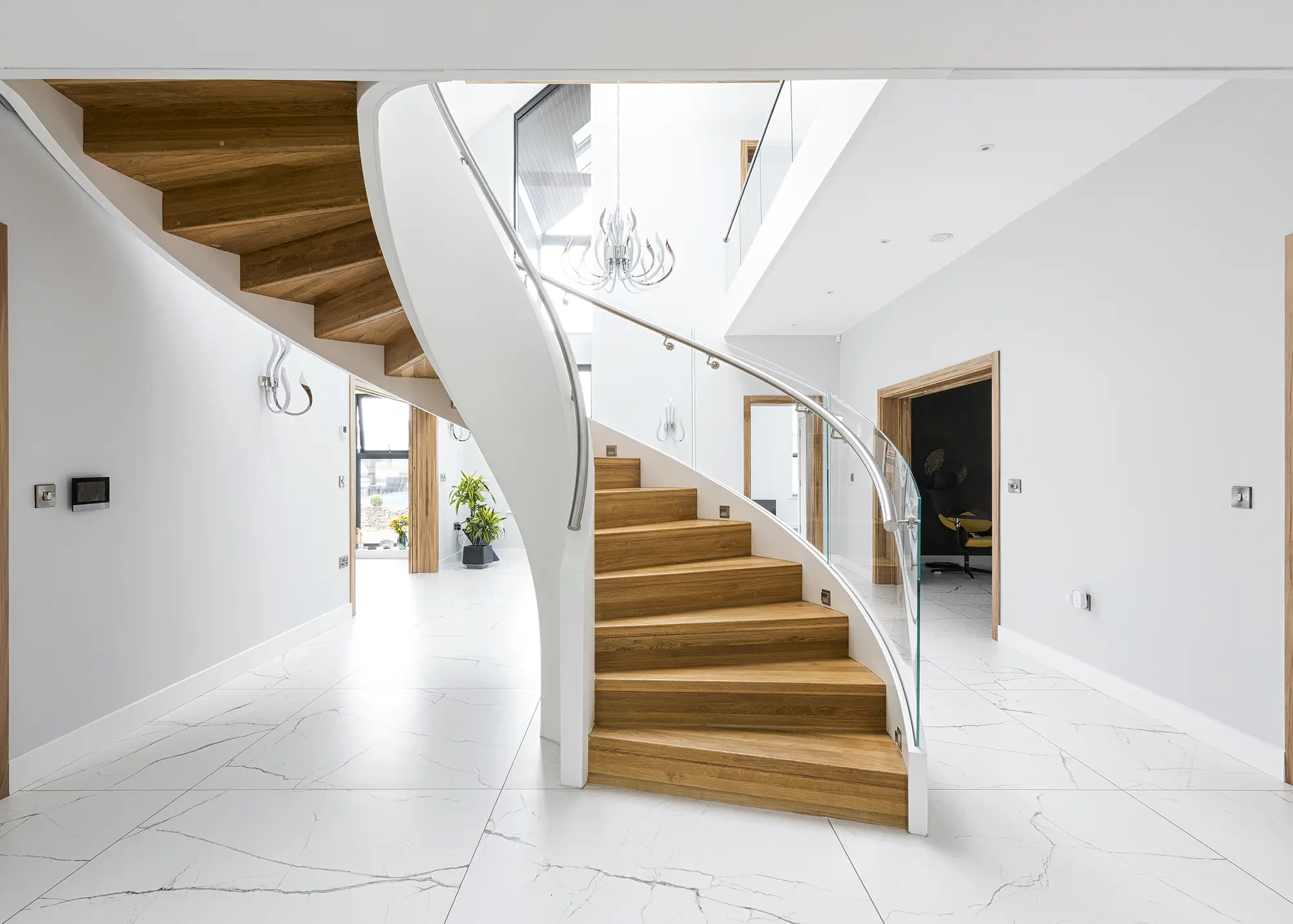
The model 500 by Complete Stair Systems is made completely bespoke with steel stringers, 50mm solid timber treads and a choice of complementary balustrade options. This design includes a stylish mix of charming, gold-toned wood steps, plus statement black steel fixings and a glass balustrade.
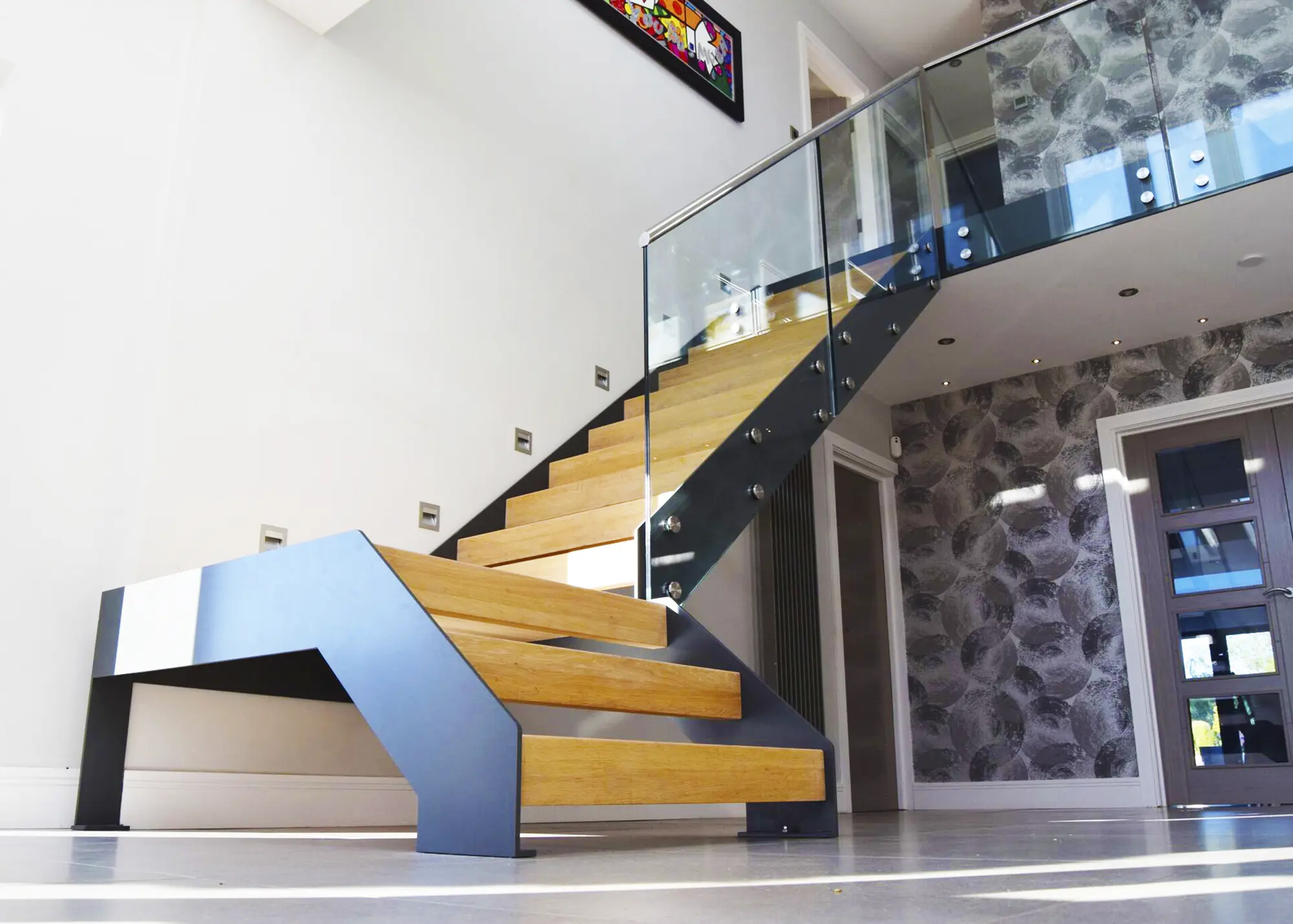
Jim and Lesley Driver replaced a poorly-insulated coastal bungalow with a highly-efficient ICF home, true to the area’s Bauhaus roots. The couple designed a bespoke, standout U-shaped steel and walnut staircase for the scheme, which features glazed balustrades. It was crafted in parts by London Joinery.

Photo: Simon Maxwell
Crafted using European oak for a sturdy, self-supporting design, this scheme by Max-Stairs features wow-factor oval-shaped risers to ensure light can flow throughout the home’s entrance. Toughened, laminated glass panels and curved newel posts work together to make a modern statement.
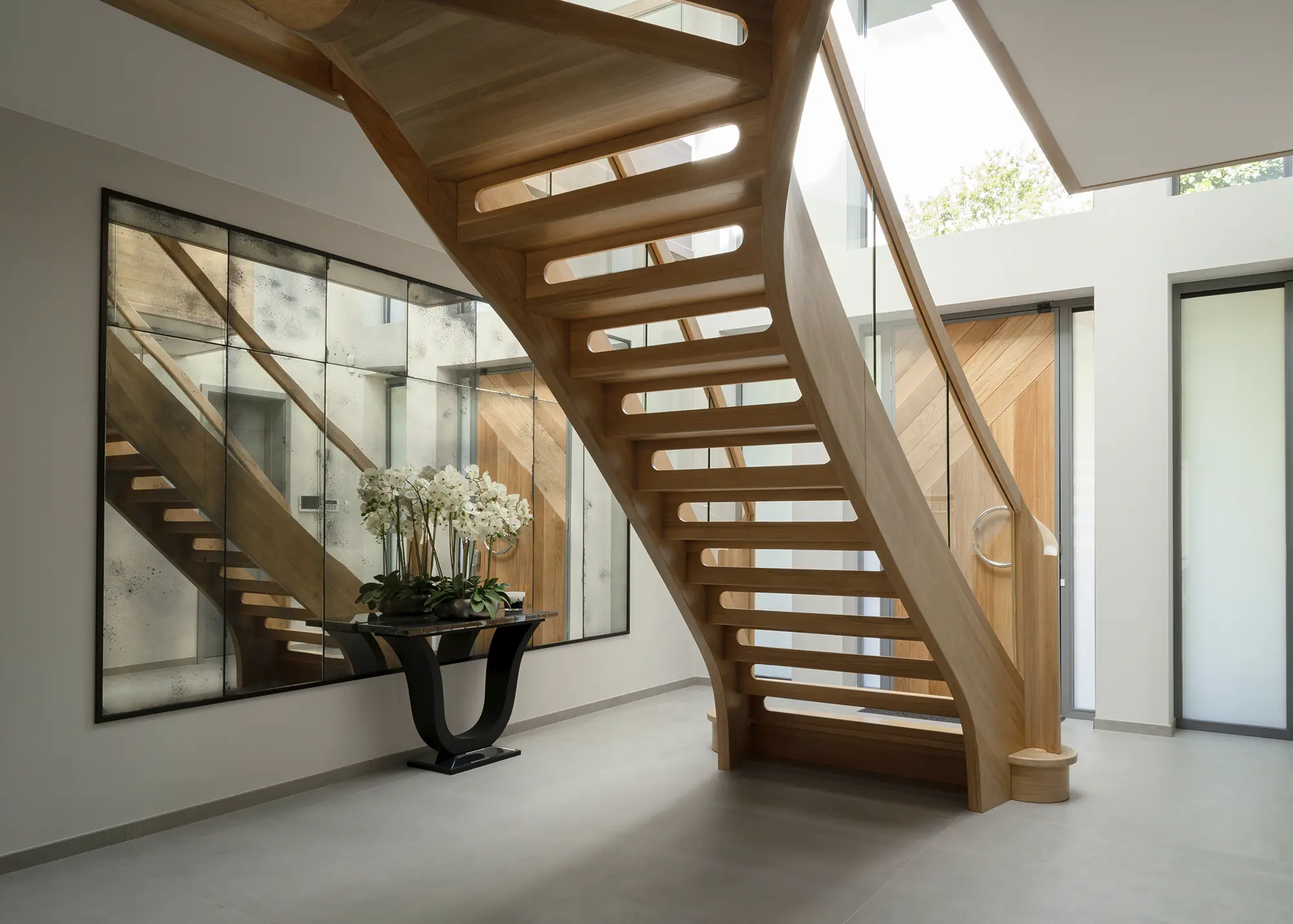
Winner of the 2024 Build It Award for Best Staircase, this sculptural design by First Step Designs makes a grand statement in this home’s hallway. The flight is meticulously detailed, with solid metal spindles and 112mm European white oak treads, sourced from FSC-certified suppliers in Italy.
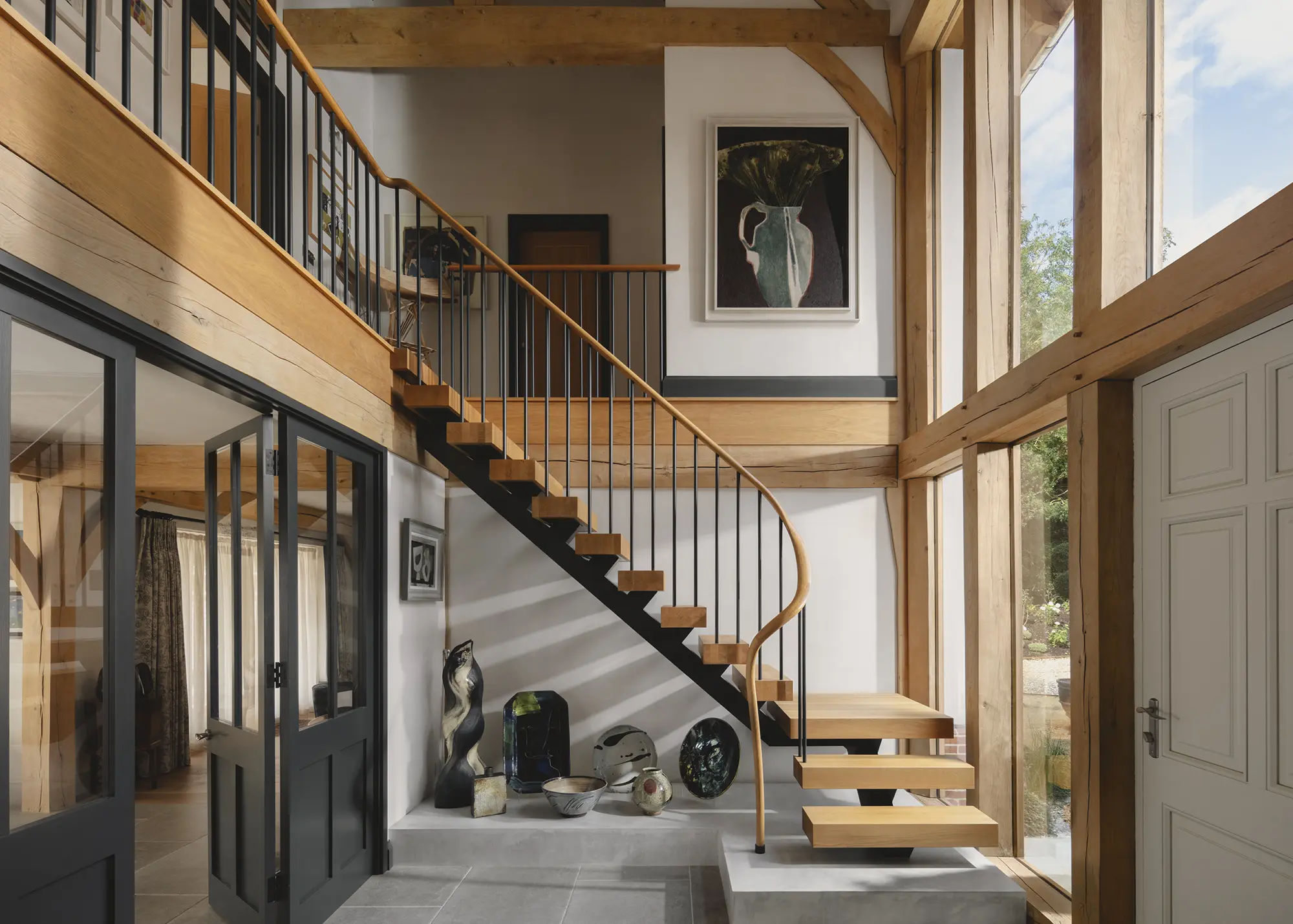
Oak is one of the most characterful hardwood timbers you can choose for your staircase design. An instant classic, it’s extremely resilient and hardwearing – ideal for high-traffic zones like stairs. In this project by Snell David Architects, oak treads have been paired with a frameless glass balustrade to create an impressive floating effect.
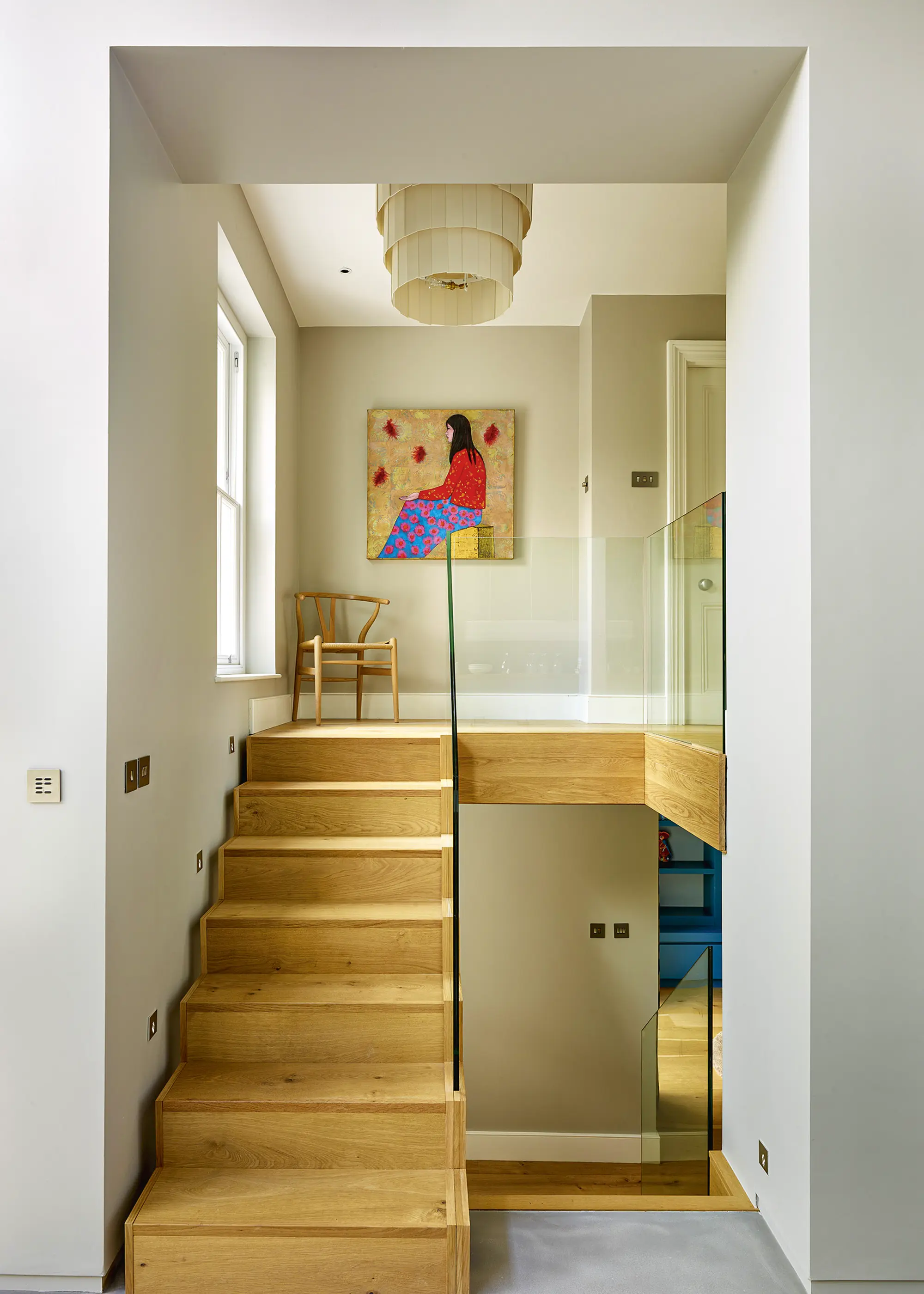
Photo: Kitchen Architecture
Although typically more expensive than timber, steel is a long-lasting and cost-effective choice for those seeking to make a contemporary or industrial-style statement with their staircase ideas. Bear in mind it can be trickier to customise if you ever want to refurbish your interiors. A carefully-curated palette of materials has been embraced in this Build It Award-winning self build project by Hyde + Hyde Architects, including the striking steel staircase design.
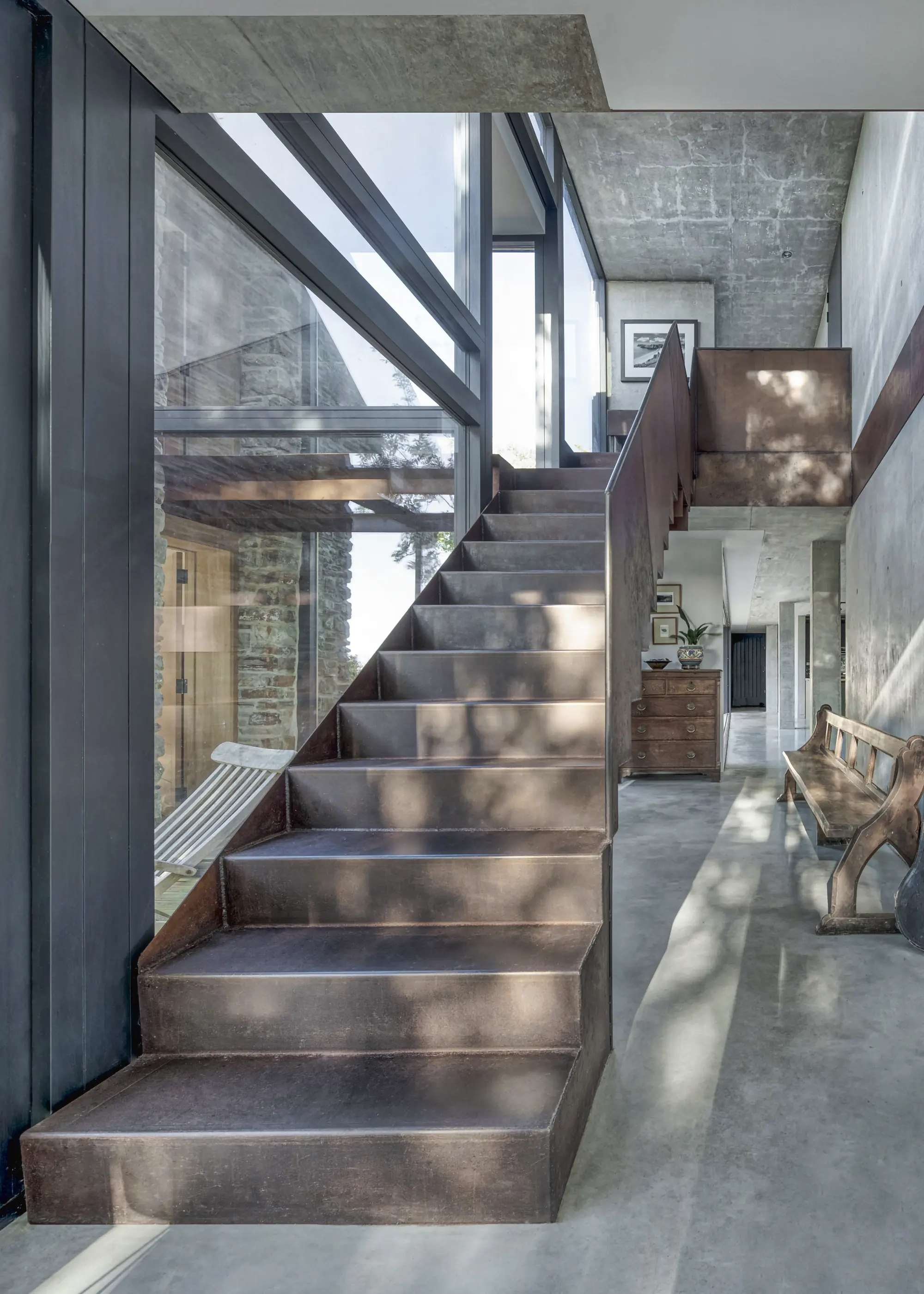
Photo: Martin Gardner
Minimalist and luxurious, there are numerous ways glass can be used in your staircase ideas. Its transparency gives a barely-there effect, allowing light to pass through for a bright, airy and open space.
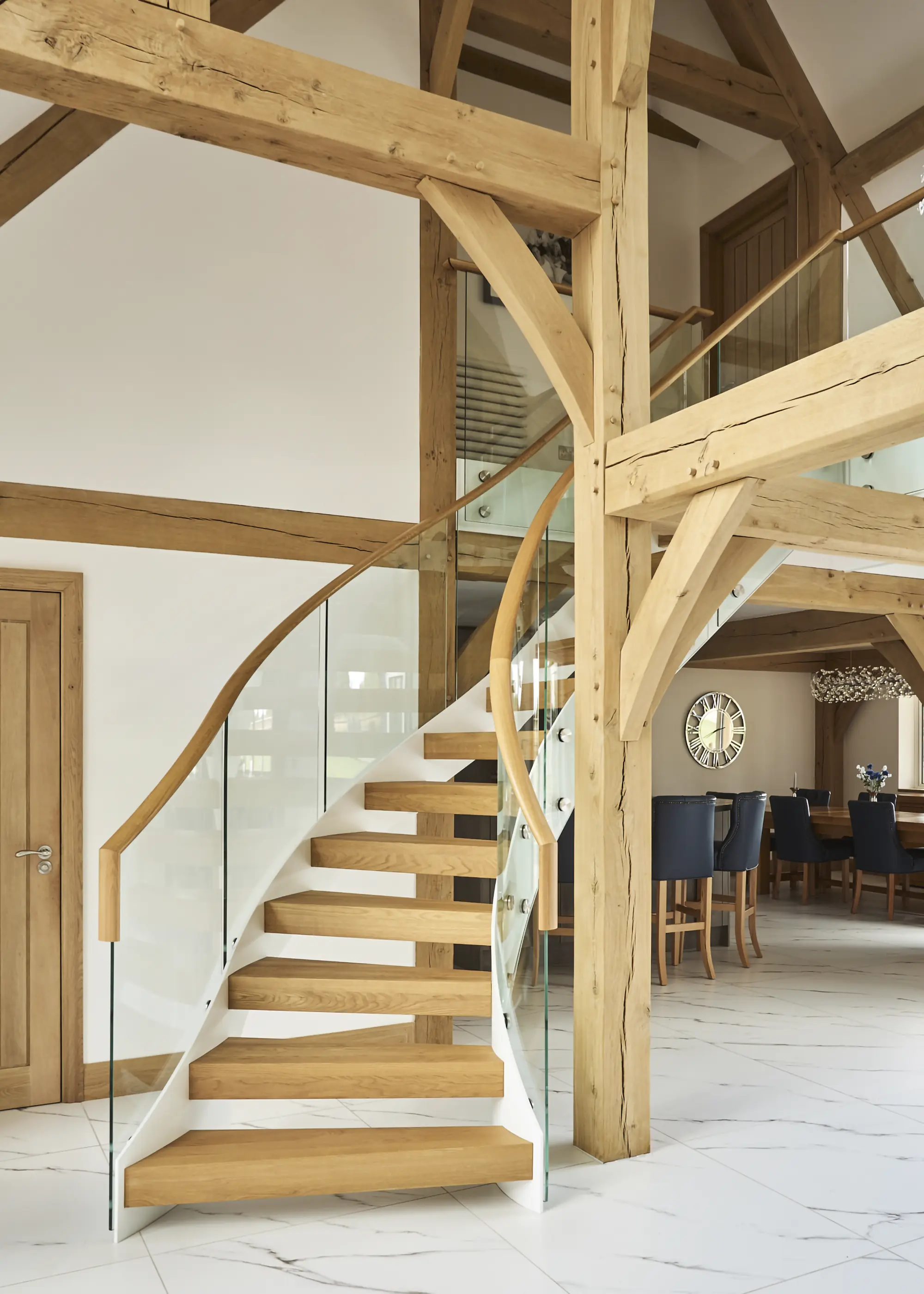
Structural glass is made to be strong, and can even be used as a walk-on material. First Step Designs elevated this oak frame home with a completely bespoke helical staircase design that features oak treads and a toughened, curved glass balustrade.
Bisca won the Build It Award for Best Staicase at the 2023 Build It Awards. Described by one Awards judge as “pure sculpture”, their amazing, Recycled Timber Staircase was completed for a barn conversion in Northumberland. The flight forms a dramatic focal point in the centre of the living space.
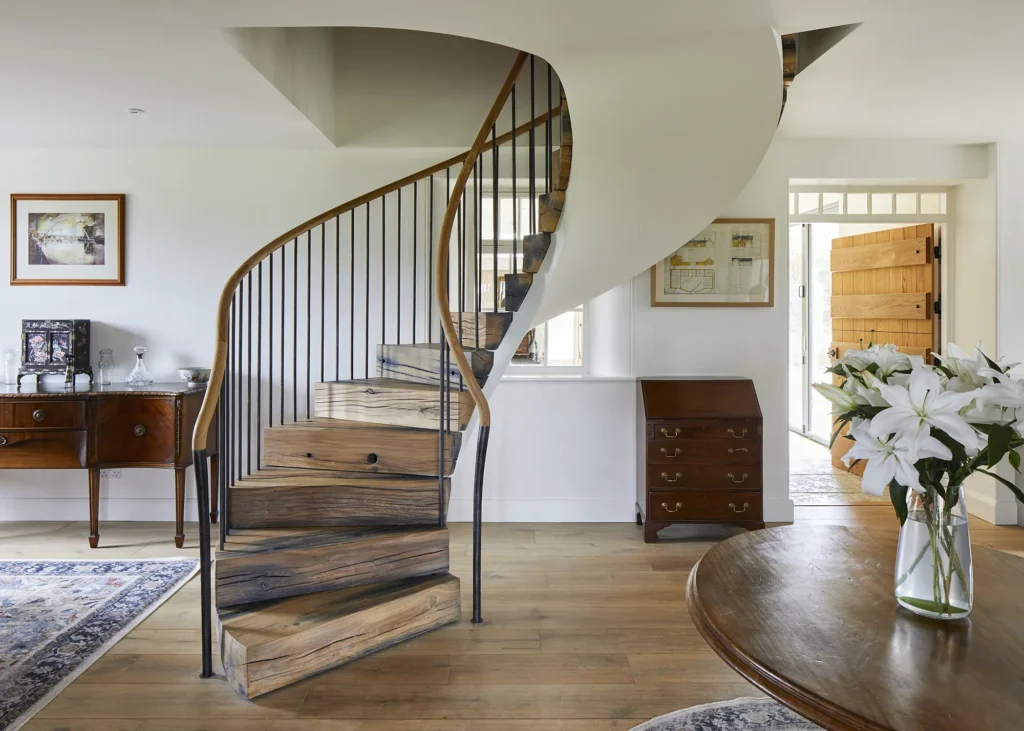
Finished to perfection, the helical staircase’s rustic character adds instant wow factor to the house. The white-painted support structure provides a contrast to the palette of natural timber.
Concrete staircase designs look great in modern homes. They can be costly and, depending on whether they’re precast or cast in situ, tricky to install. But the material’s strong load-bearing capacity, low maintenance and virtually fireproof nature justify the price point.
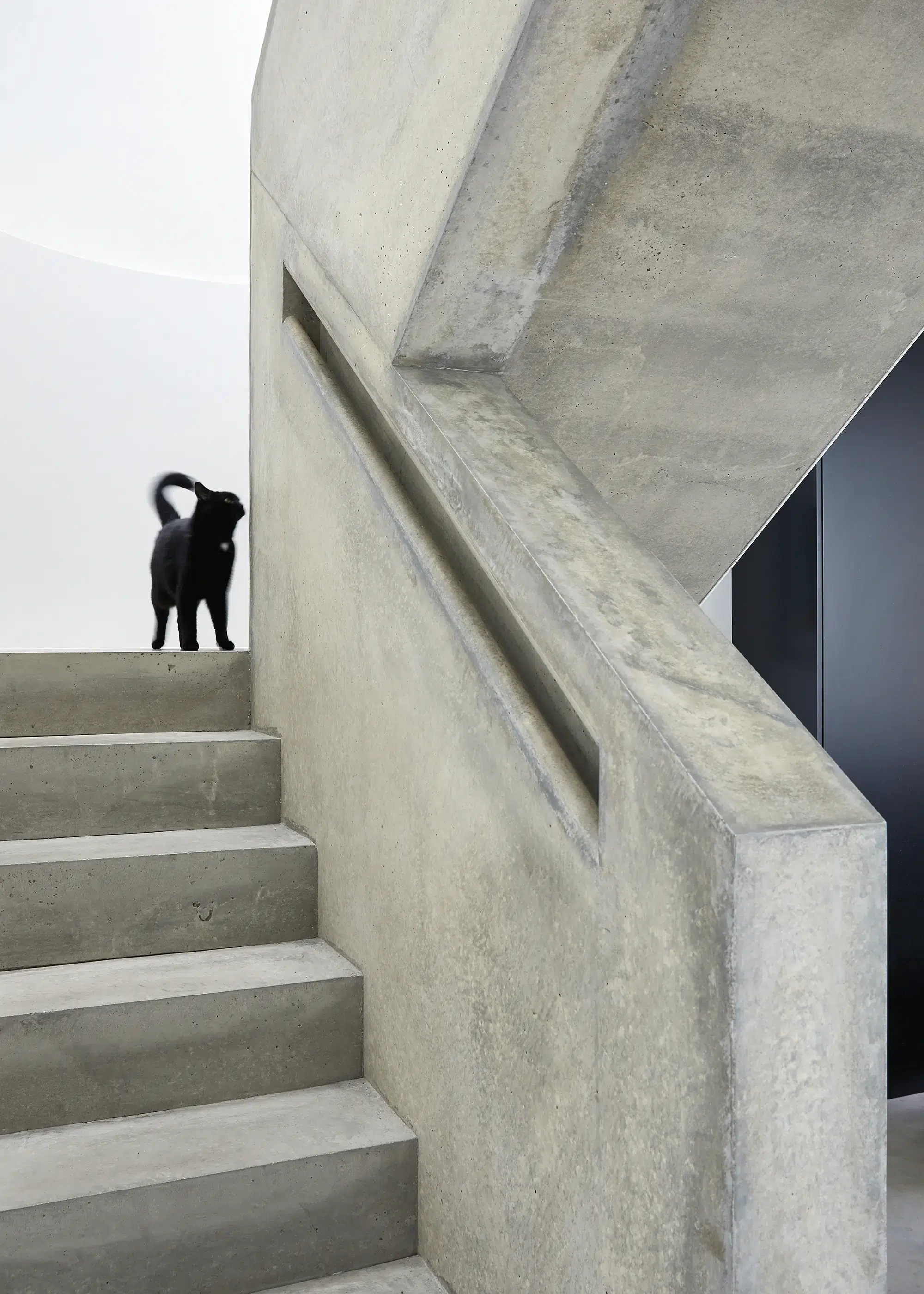
Photo: Andy Stagg
Cast on site, this concrete stairway leads down to the lower ground floor of this Victorian renovation by Paul Archer Design.
Like timber, stone stairway designs are timeless. They’ve been around for centuries and although typically traditional, they can easily form part of a modern design.
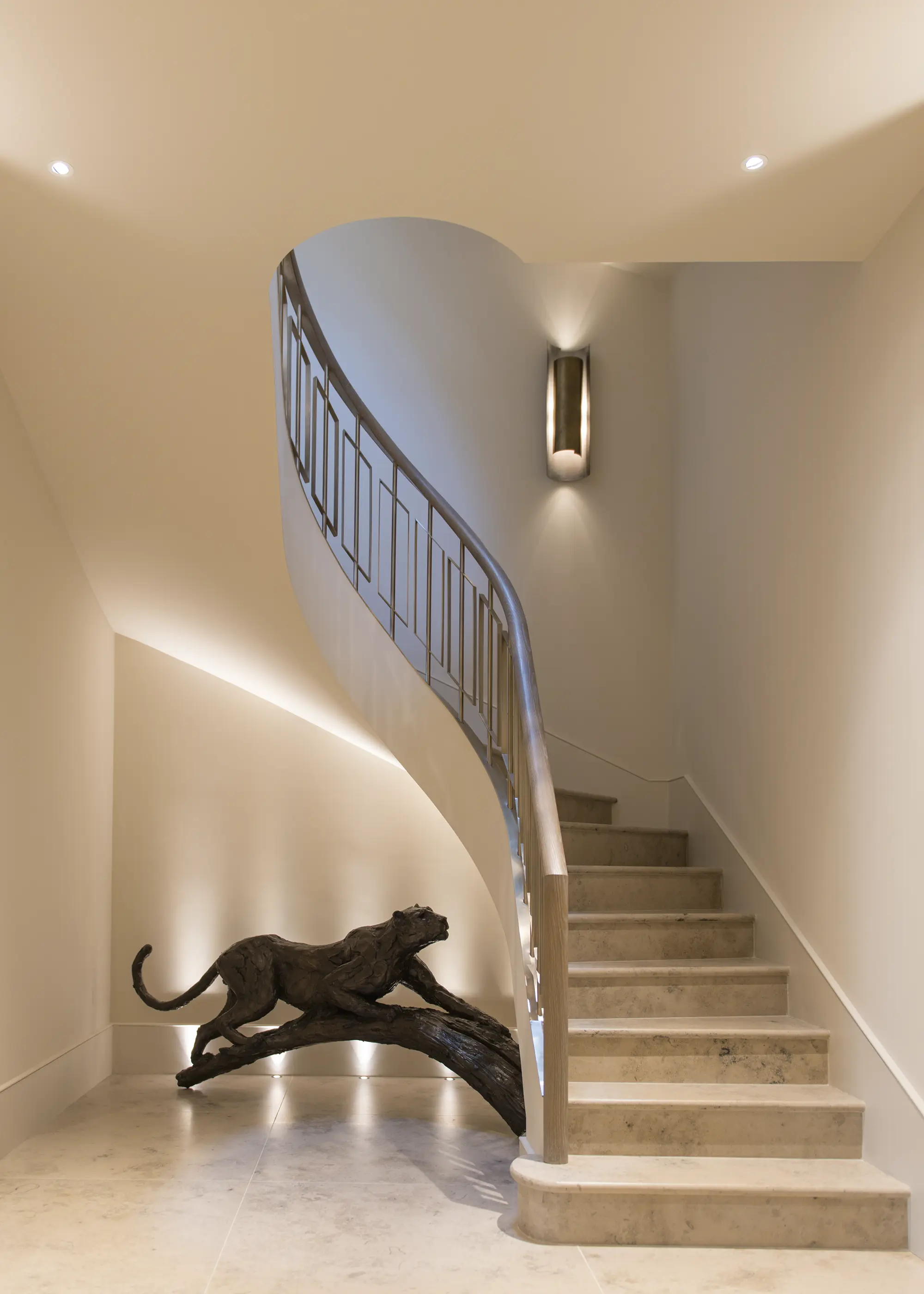
Photo: Will Layzell
Stone comes in at the top end price-wise, but this kind of flight will have outstanding longevity and become a feature that can increase your home’s value. In this project by Nash Baker Architects, the contemporary helical staircase is clad in stone.
Warm and characterful, timber is one of the most popular staircase materials. It’s just as capable of creating a contemporary staircase design as it is a traditional one. Choose from options such as engineered pine (which can be painted or stained) through to pricier hardwoods like mahogany and walnut.
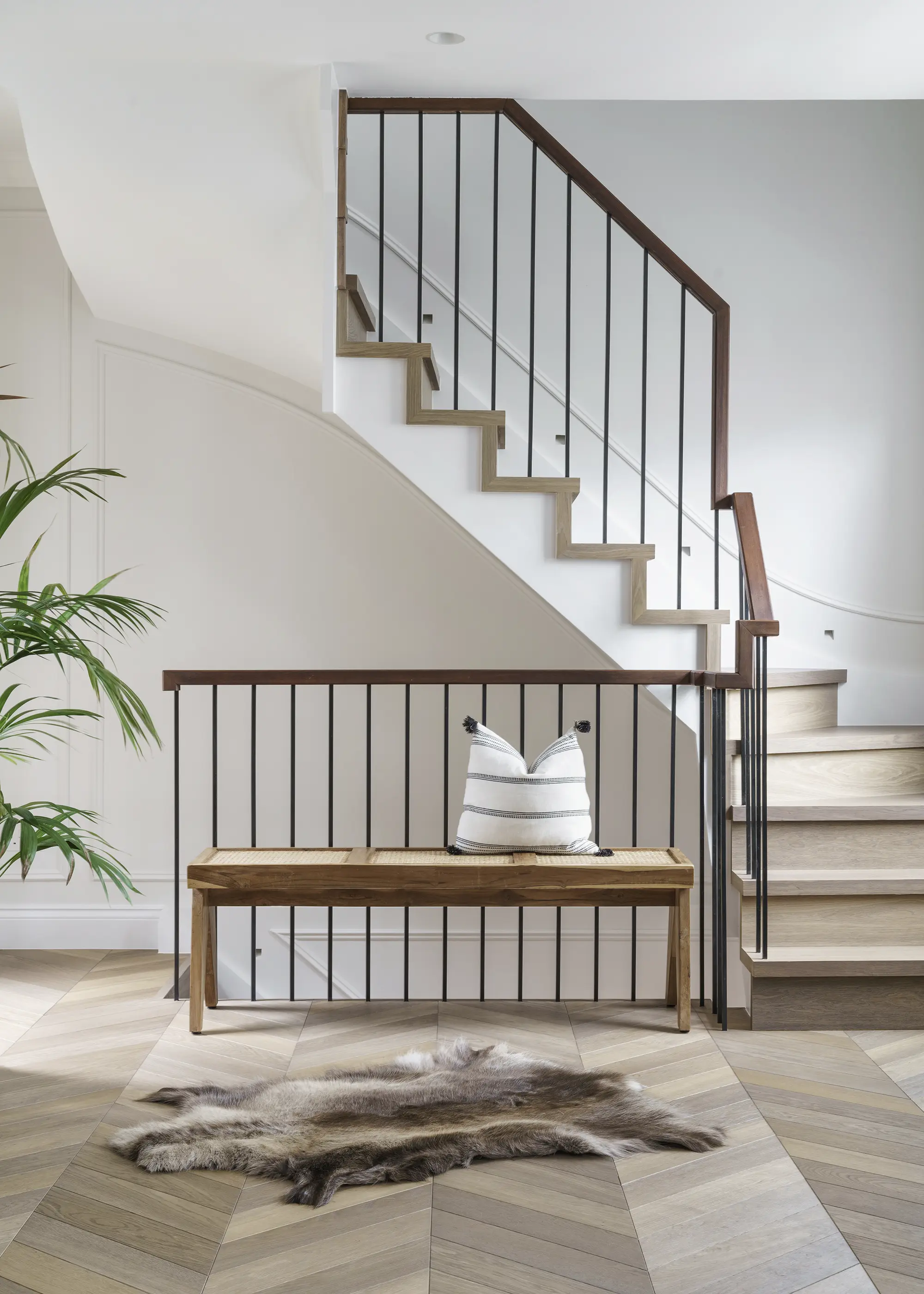
Photo: Vigo Jansans
This Havwoods timber flight, featuring metal balusters, was designed in collaboration with Aflux Designs.
Suzie and Sam Andrews’ focus for their self build project was creating a light-filled and open family home. Central to this plan was their bespoke L-shaped staircase from PM Large Joinery, which sits at the heart of their grand entrance hallway.
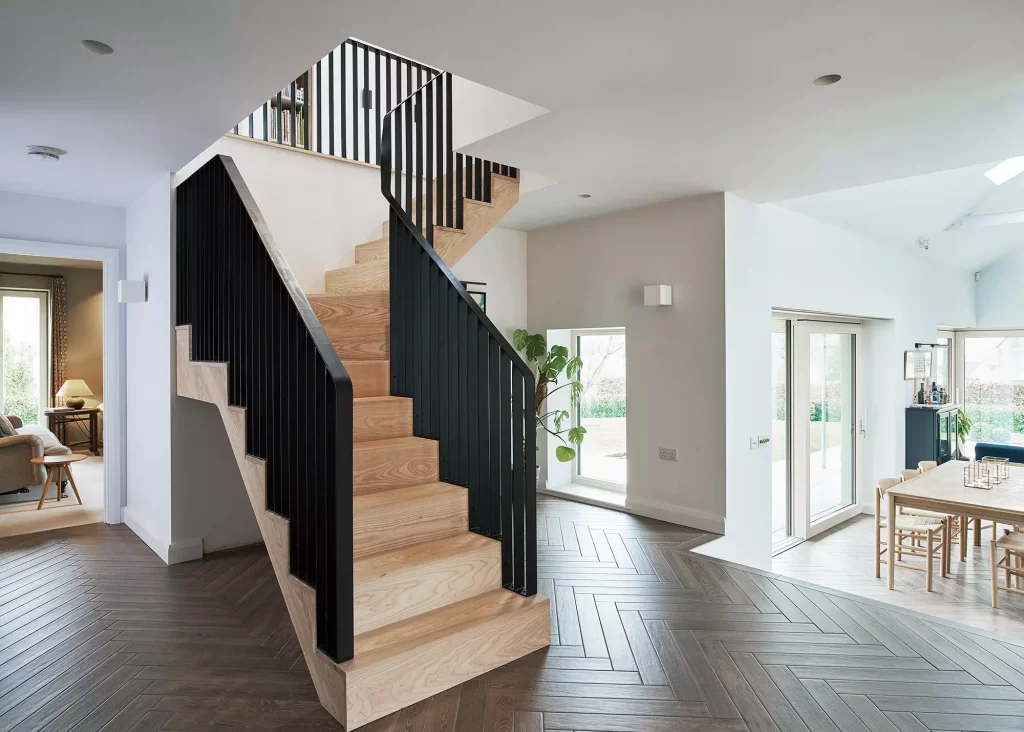
Photo: Adam Carter
The flight supports steel balustrades and leads up to a light-filled landing, adding a contemporary addition to the interior.
When collecting your staircase design ideas, think about how you can arrange a scheme to not block out any essential daylight or views.
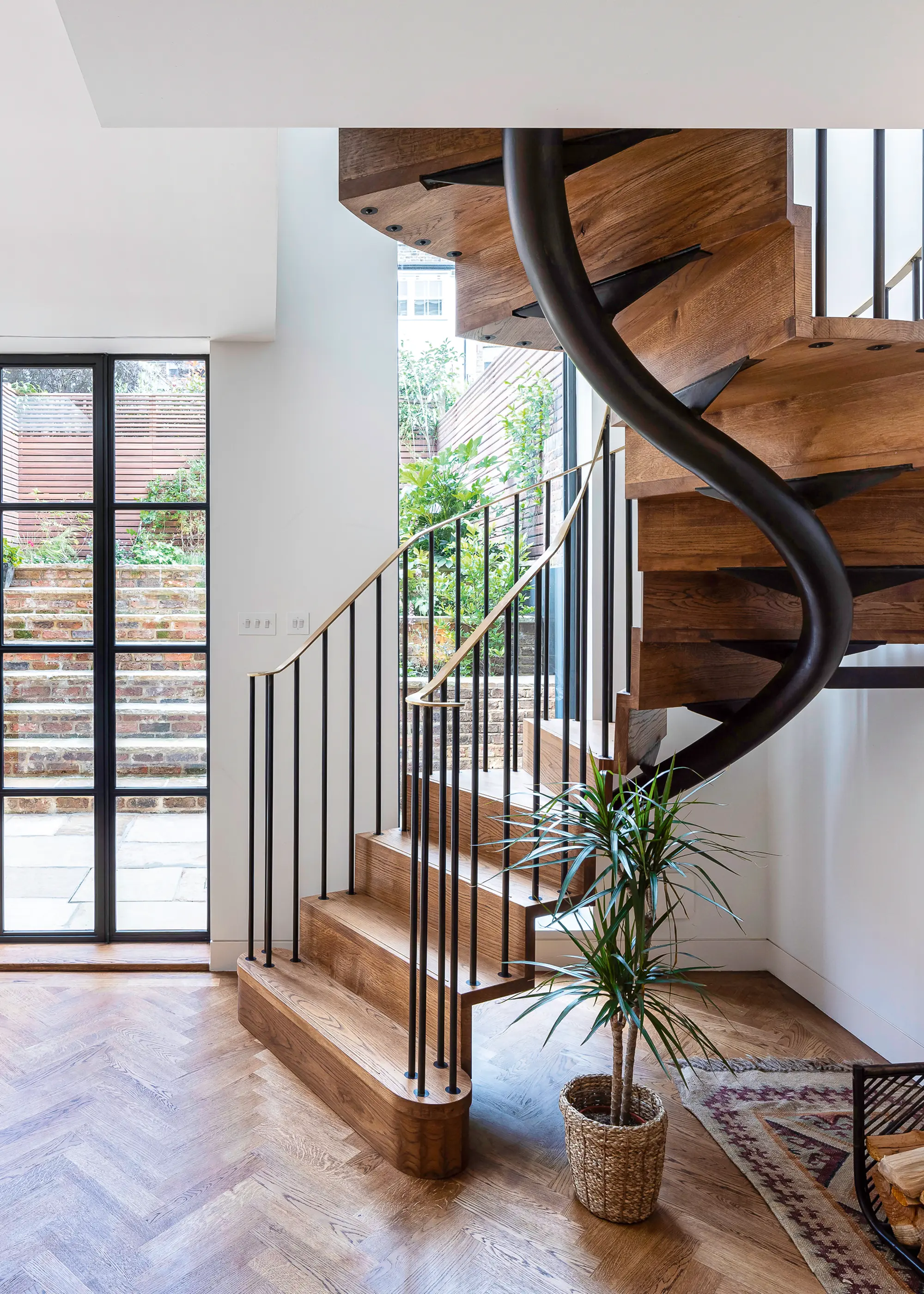
Photo: Peter Landers
Cake Industries worked with Chris Dyson Architects to design this semi-spiral staircase made up of a hollow circular spine in rolled steel, solid oak treads and a brass handrail. The spiral design and delicate spindles allow light from the tall window to fill the interior.
This standout T-shaped staircase was pivotal to the success of Colin White and Annette Siddle’s renovation project, bringing a focal point to the home while providing an effective connection to the rooms on the upper level.
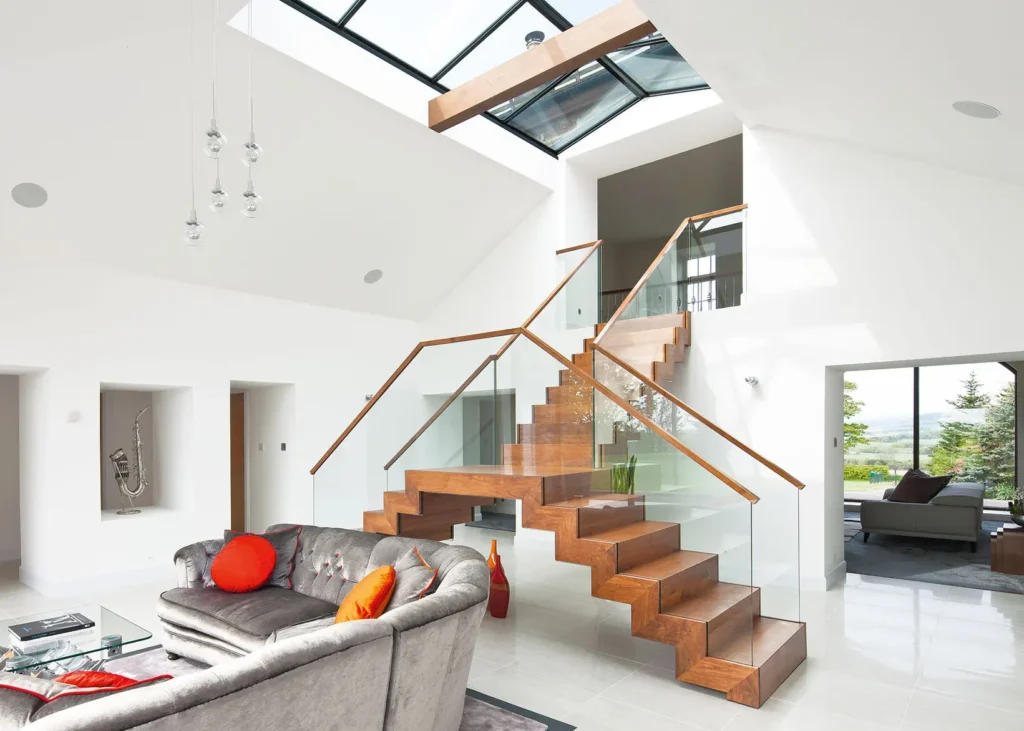
The steel stairs arrived in sections, with a local joiner and cabinetmaker completing the American walnut clad joinery.
Gathering staircase ideas is an important part of designing a home, as this structural addition can take up more space than you’d expect. Therefore, ensuring the flight fits your scheme will be key to success, helping to enhance and blend with any distinctive features or colours.
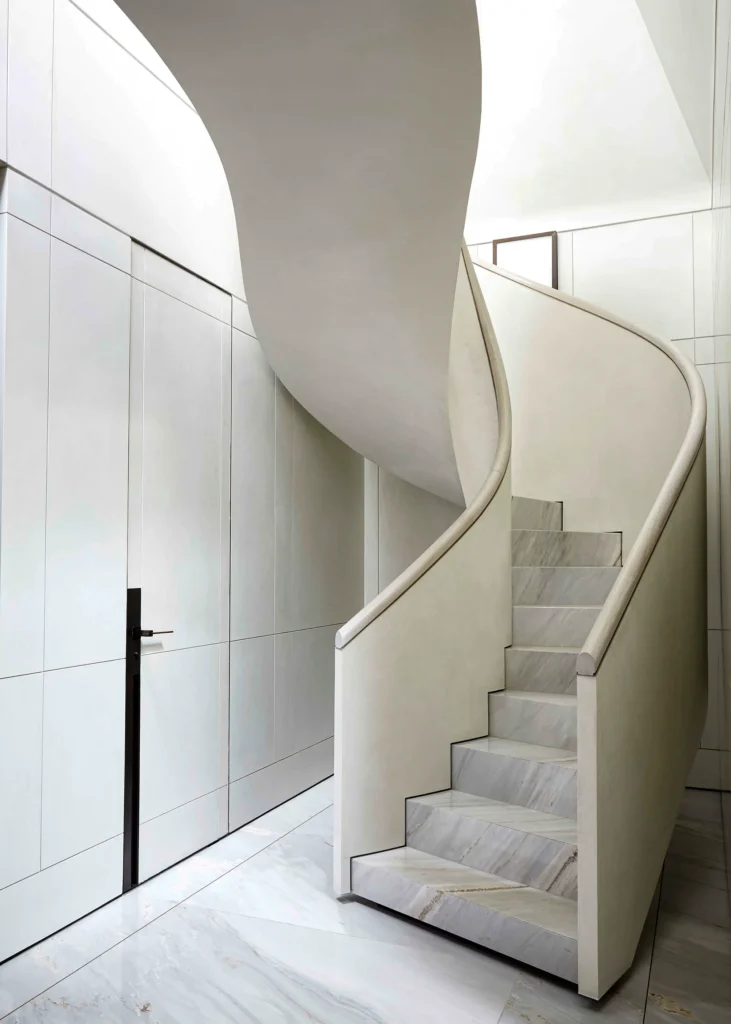
Designed in collaboration with architectural practice D-Raw, this helical staircase has marble treads and risers and a plaster balustrade that sits beautifully in the home’s white interior scheme. Bespoke Bisca staircases start from £30,000.
Bisca supplied this bespoke spiral staircase as part of a comprehensive renovation project to connect the kitchen and basement. The pale timber block treads are supported with a central core, providing a distinctive and stacked look.
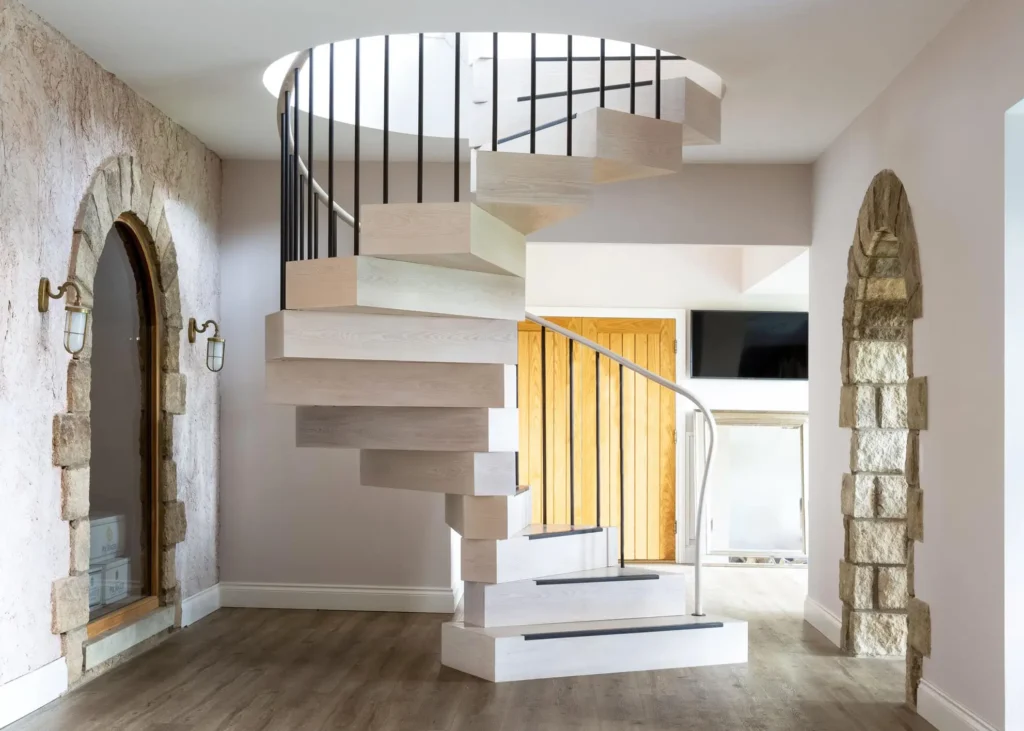
This timber staircase has cantilever-style treads and contrasting steel spindles. A Complete Stair System design in any hardwood costs approximately £6,000-£10,000.
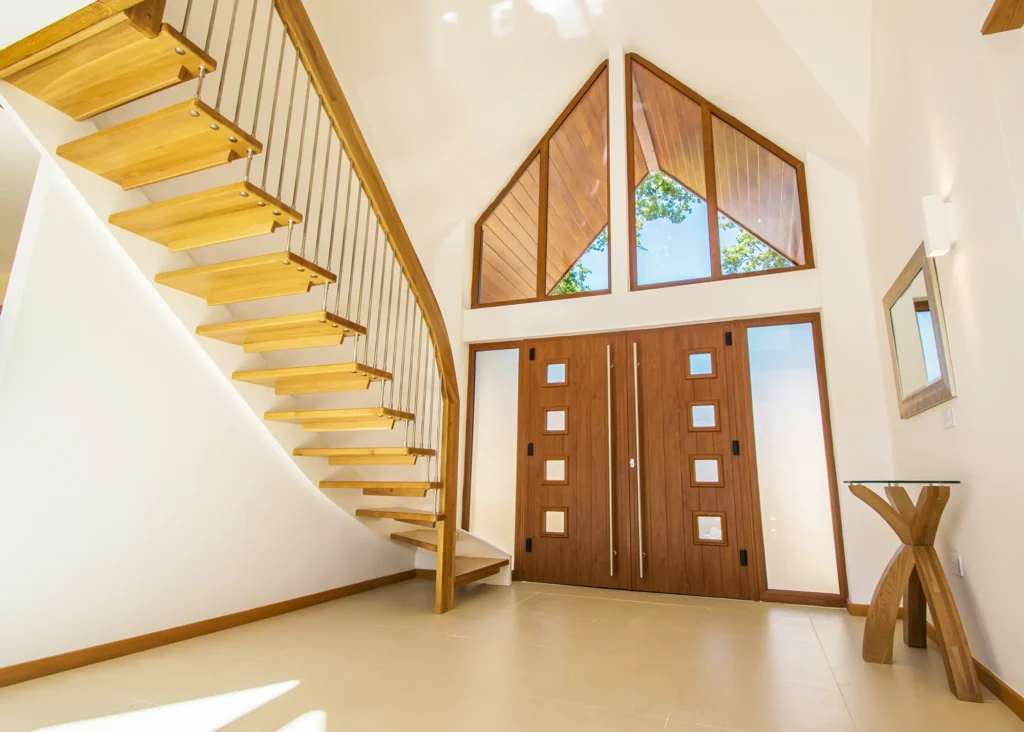
A bifurcated flight will certainly make a wow-factor focal point. This stately timber staircase by David Smith St Ives oozes opulence, boasting intricate newel posts and spindles with a red carpet runner for a regal finish.
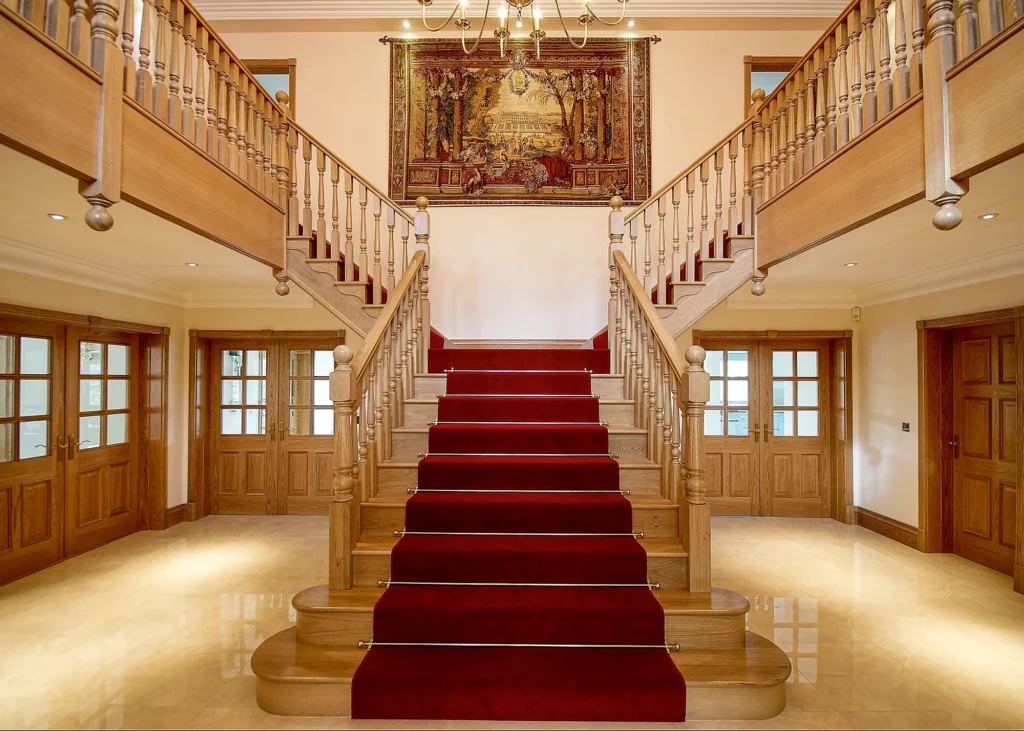
Mata Architects opted for a straight staircase made from folded steel in this new build home. Its slim design allows it to sit perfectly in the centre of the kitchen/living space without taking up too much room.
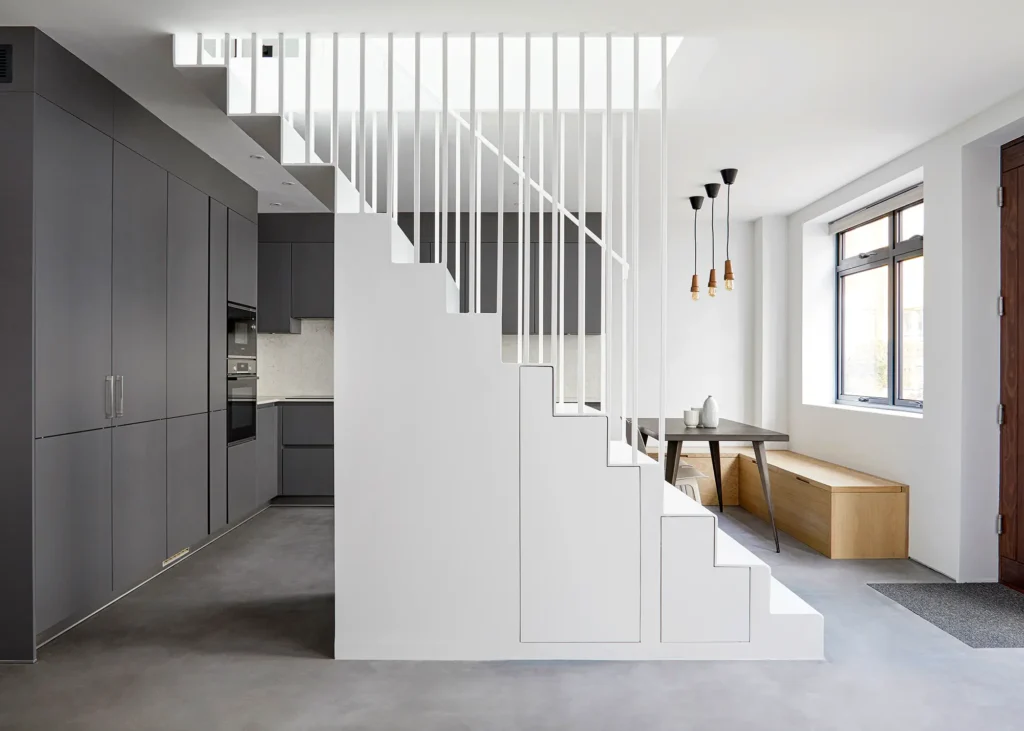
Photo: Anna Stathaki
The ribbon-like newel posts on this helical staircase by Max-Stairs make for a truly statement design.
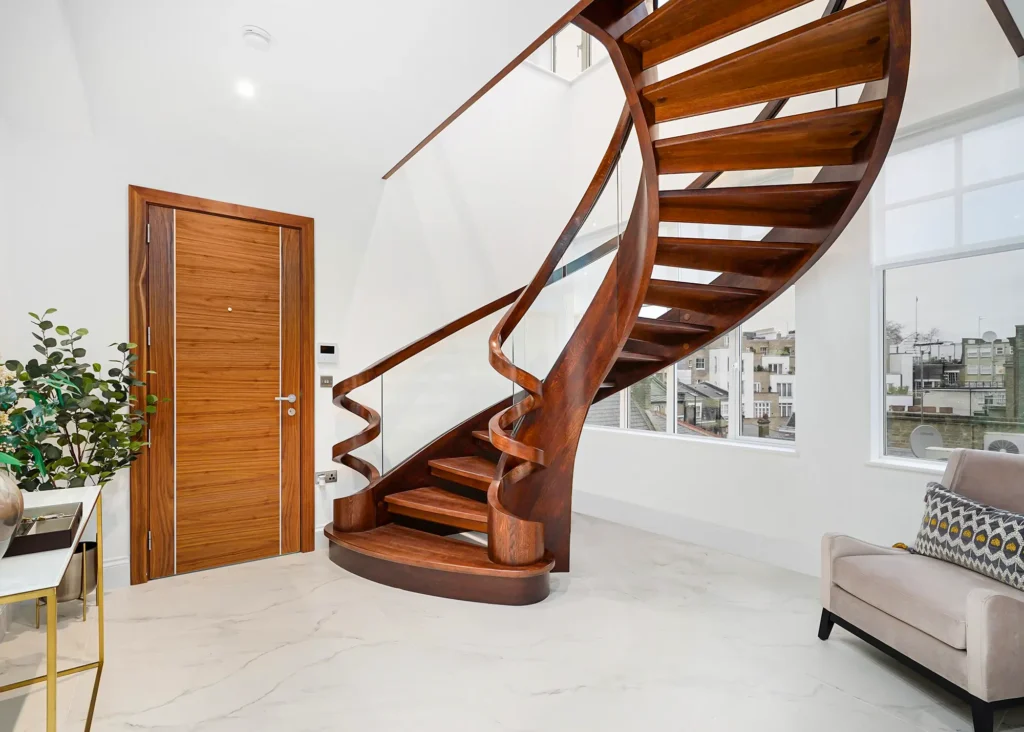
The glass balustrades appear almost invisible, letting in lots of light and giving the flight a bold contemporary touch that works well alongside the rich timber.
When developing your staircase ideas, think about the different design styles that you can mix and match with your home’s architecture. Minimalist or decorative staircase details such as patterned spindles can really emphasise different features in your interior.
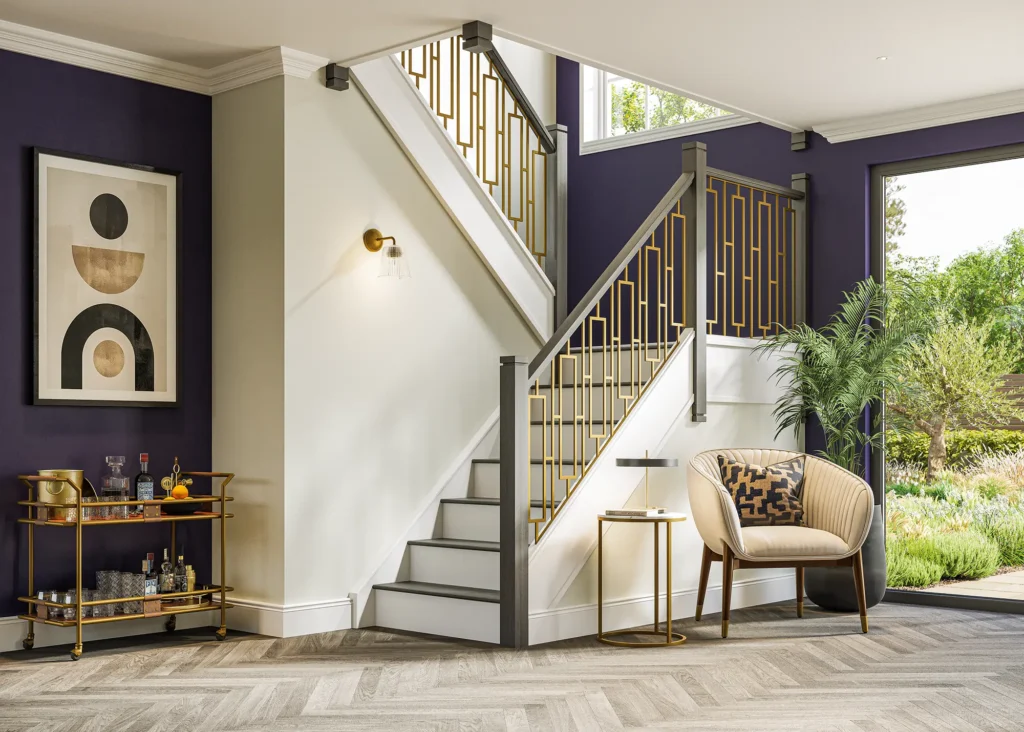
The steel spindle design on this timber U-shaped staircase by Neville Johnson gives it a luxury Art Deco feel.
This cantilevered staircase by Bisca is central to the design of the oak frame self build home. Featuring raised grain oak treads and a concealed mild steel structure, the flight twists around a curved wall – and is beautifully finished with a low-iron glass balustrade and oval oak handrail.
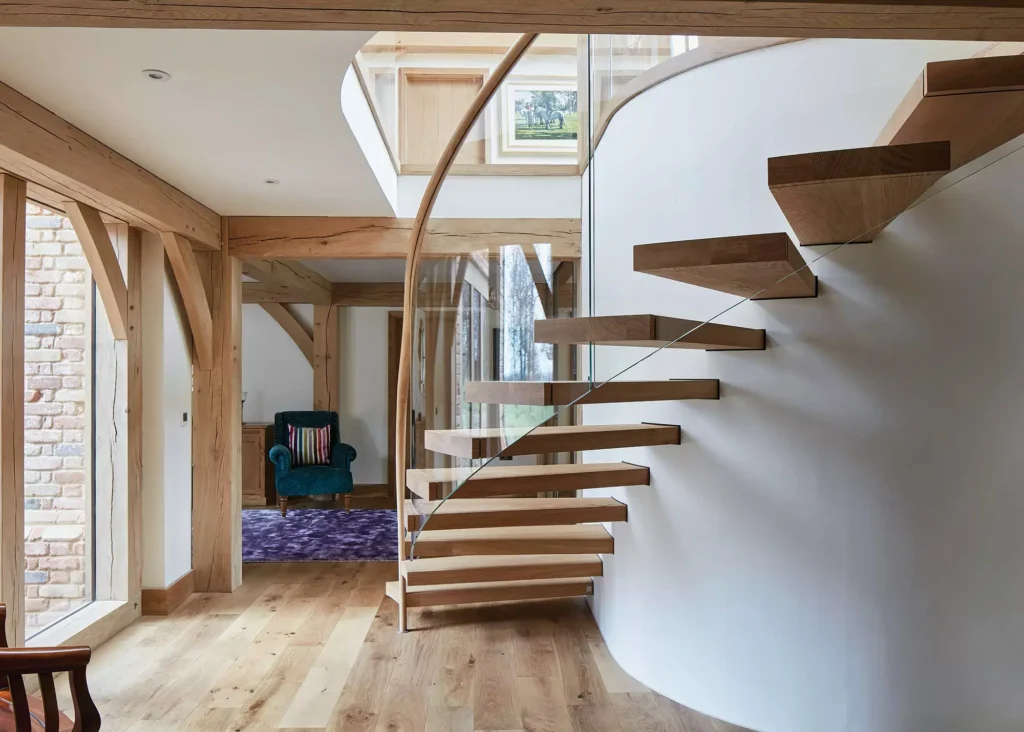
It’s paramount that you plan your staircase design from the get-go. You and your design team will need to envision the impact your staircase will have on each storey.
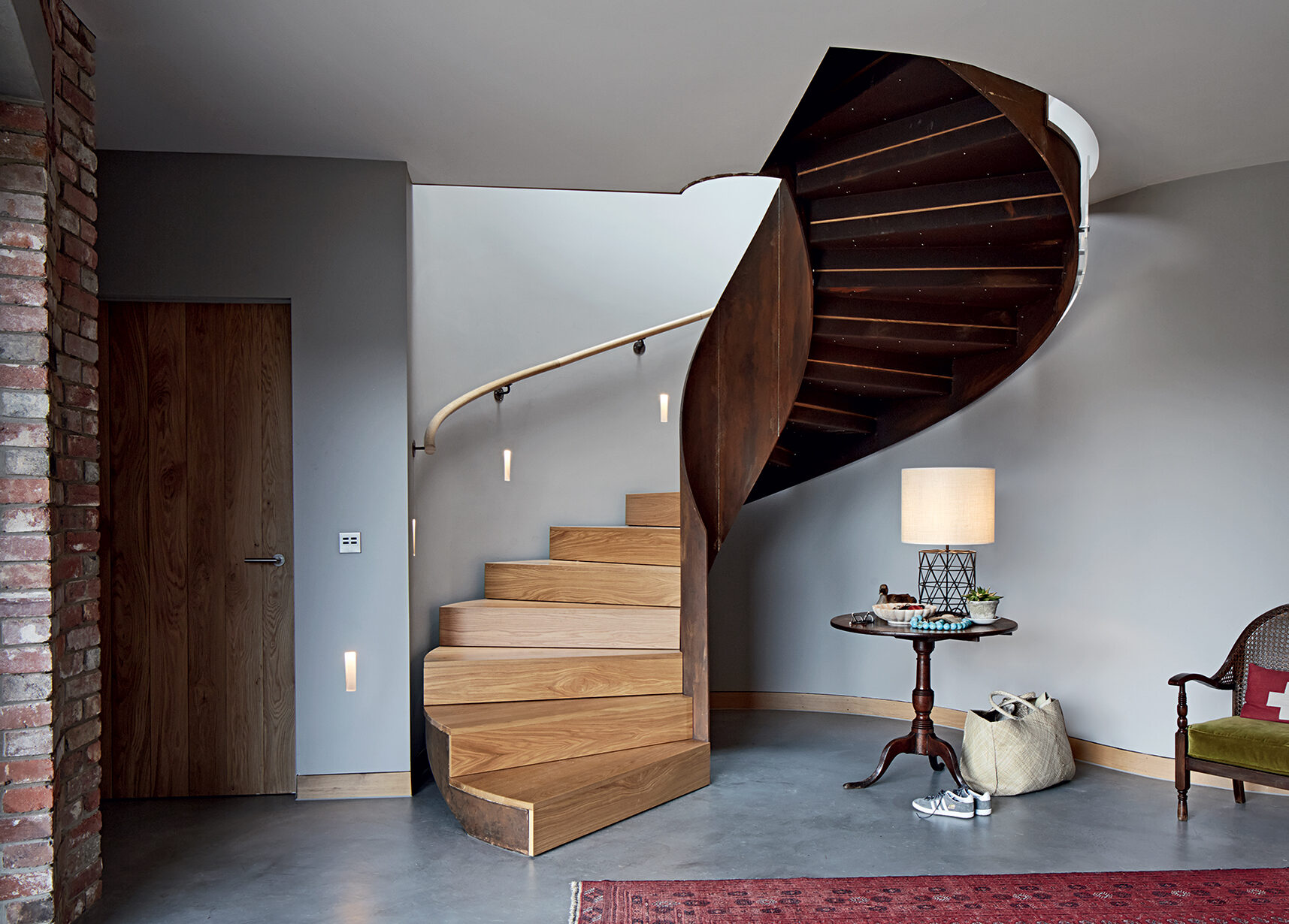
It’s also key to know how the flight will be seen from different angles – particularly if you are opting for open-plan living, as it needs to fit effortlessly within the home. This project in Jersey by Spiral UK is fabricated in Corten steel with contrasting natural timber treads for an organic, elegant design.
The limestone steps on this cantilevered design by Chesney’s Architectural curve round the corner, leaving the area below clear for furniture.
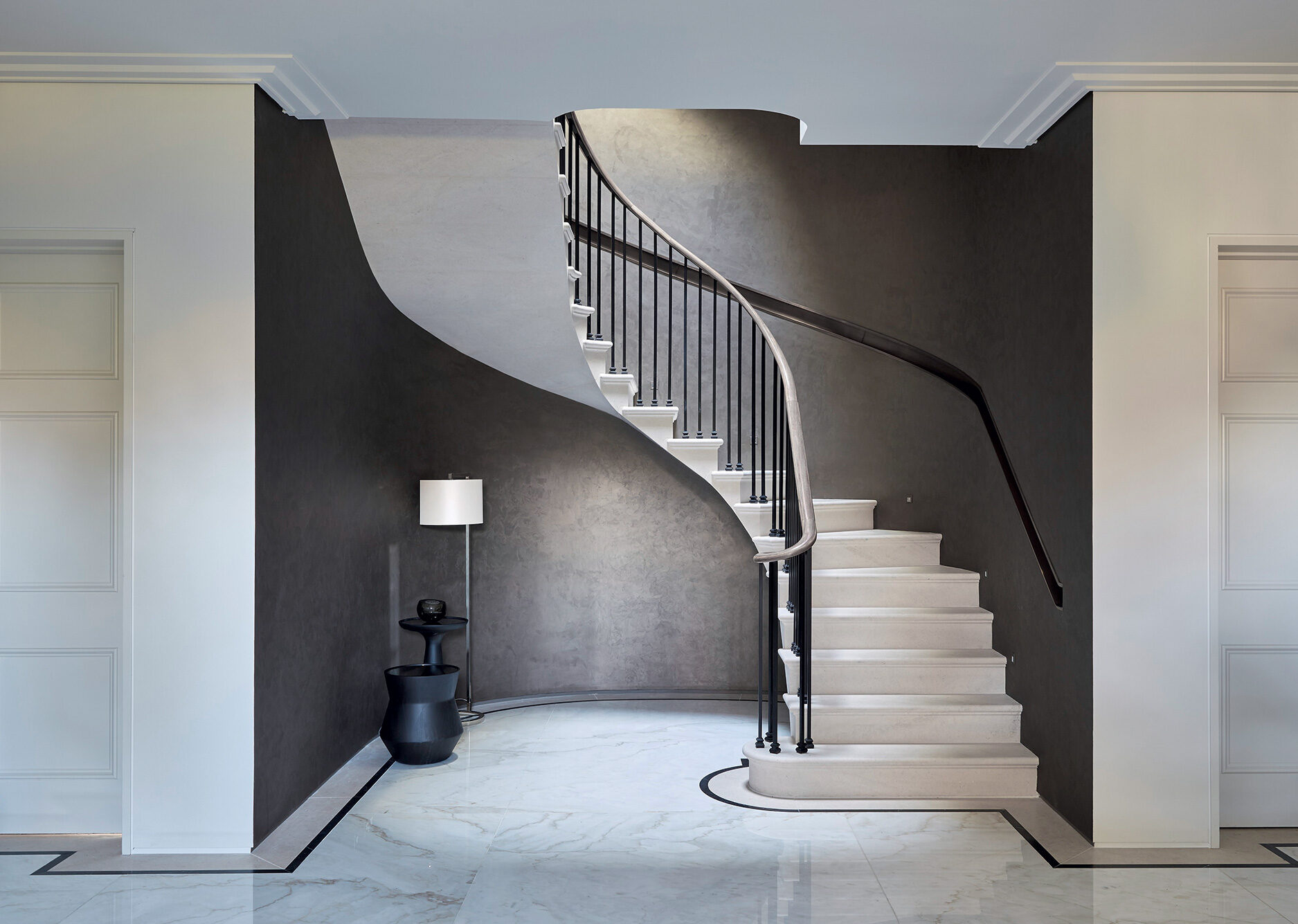
The dark, thin balusters are topped with a lighter hued handrail, which alongside the pale flight, helps to create a trendy monochrome look.
T-shaped stairs will bring real wow factor to your home. This cantilevered design (no supporting structure underneath) is the perfect match for the minimalist look in this home. Lights floods through from the upper storey thanks to the glass balustrades.

Bespoke staircase specialist Bisca was commissioned to create a new feature timber flight for a 400-year-old Devonshire shippon (cow shed).
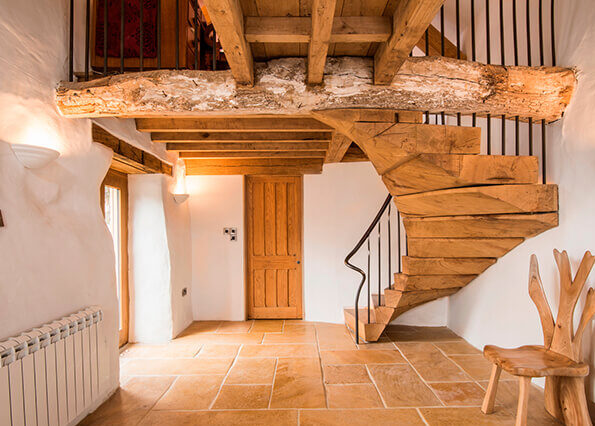
The brief was for a stair that would immediately look like part of the existing architecture, complementing the building’s humble provenance.
Spiral staircases are a great space-saving solution, creating a stylish transition between floors and adding a striking focal point to your home’s interior.
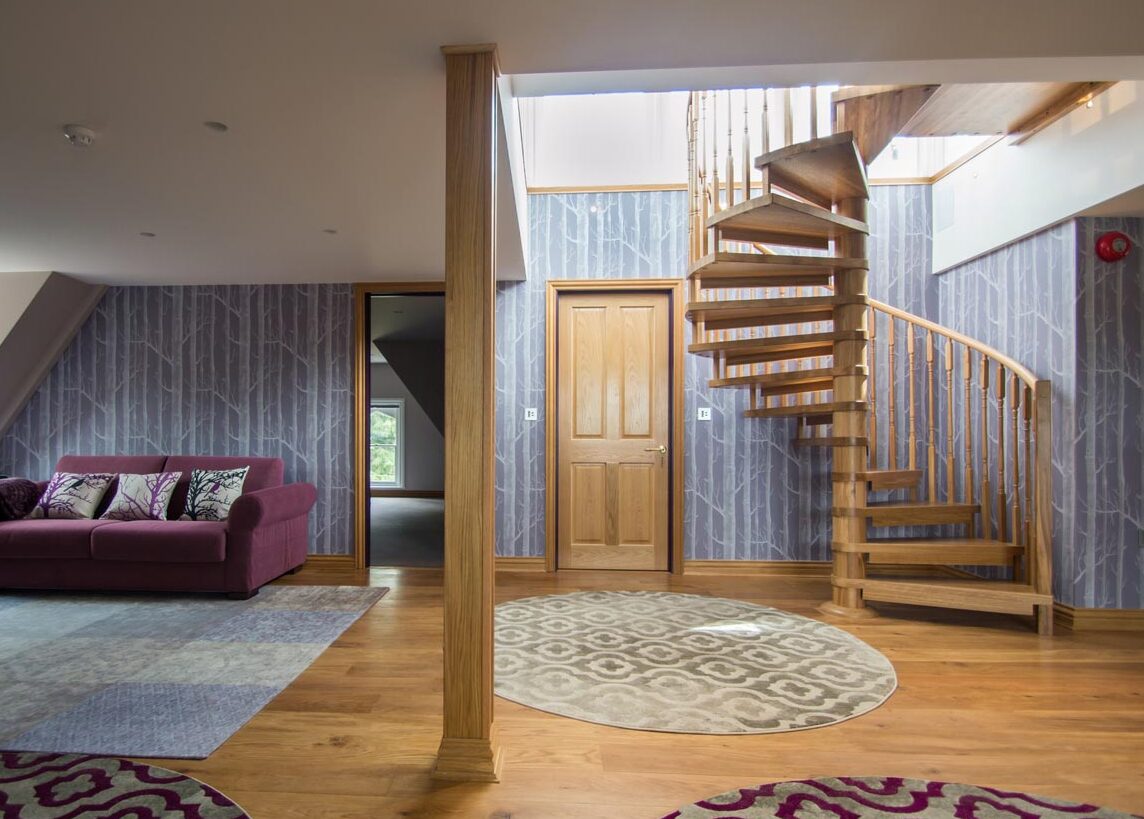
The Complete Stair Systems range of spiral staircases consists of a stunning variety of custom and kit spiral staircases for both domestic and commercial applications to provide a contemporary or traditional solution.
This stunning helical staircase features curved glass balustrades from IQ Glass. The frameless, toughened structural glazing, also present on the landings, offers clear sightlines and maximises the flow of daylight.
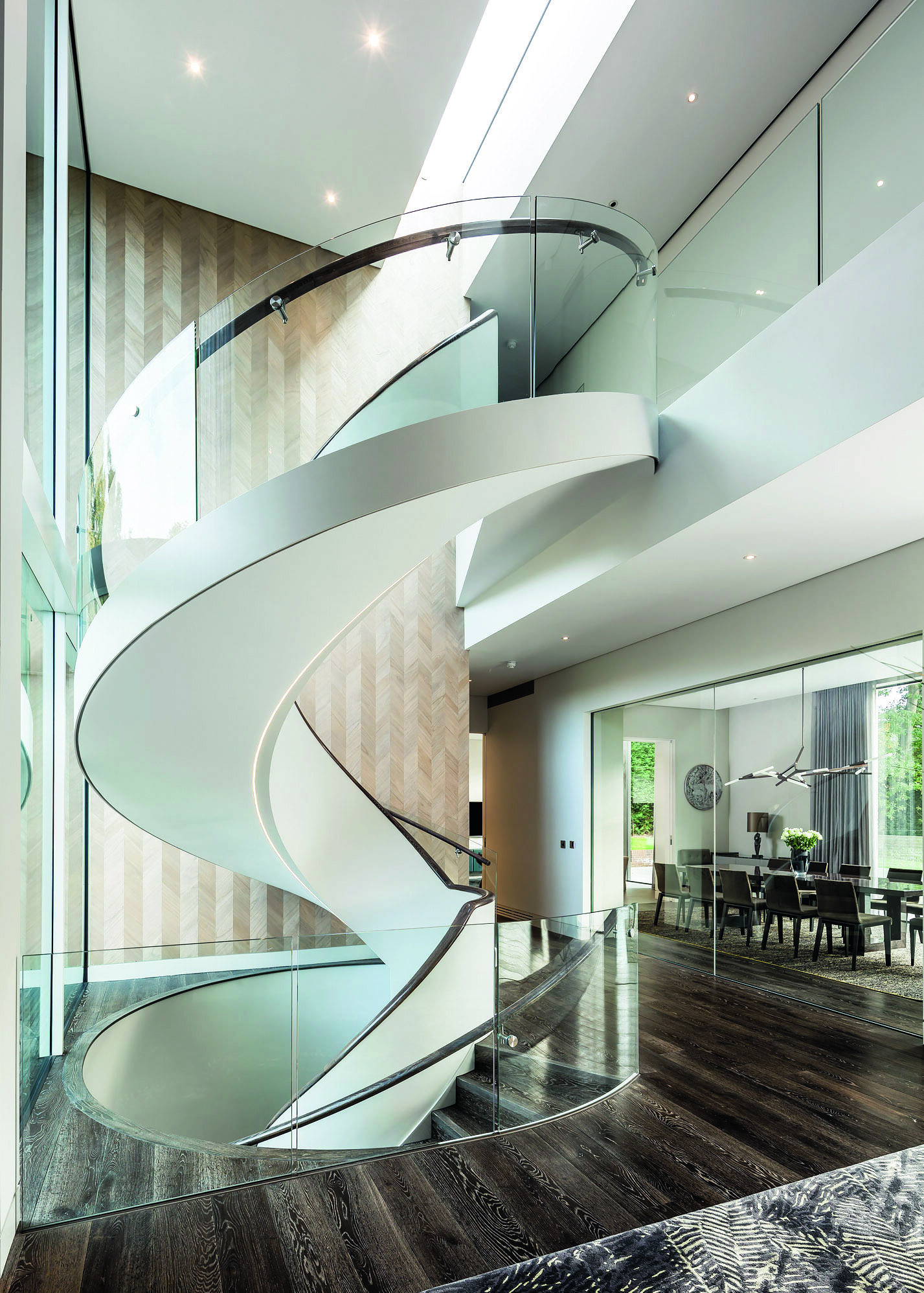
The glass has a low iron content to reduce the common green tint seen on thick panels. The sculptural flight, with its dark wood treads and handrails offset with white soffits and stringers, is by Spiral UK.
Walnut treads contrast with the white plastered soffit (underside of the flight) in this semi-cantilevered design from Bisca.
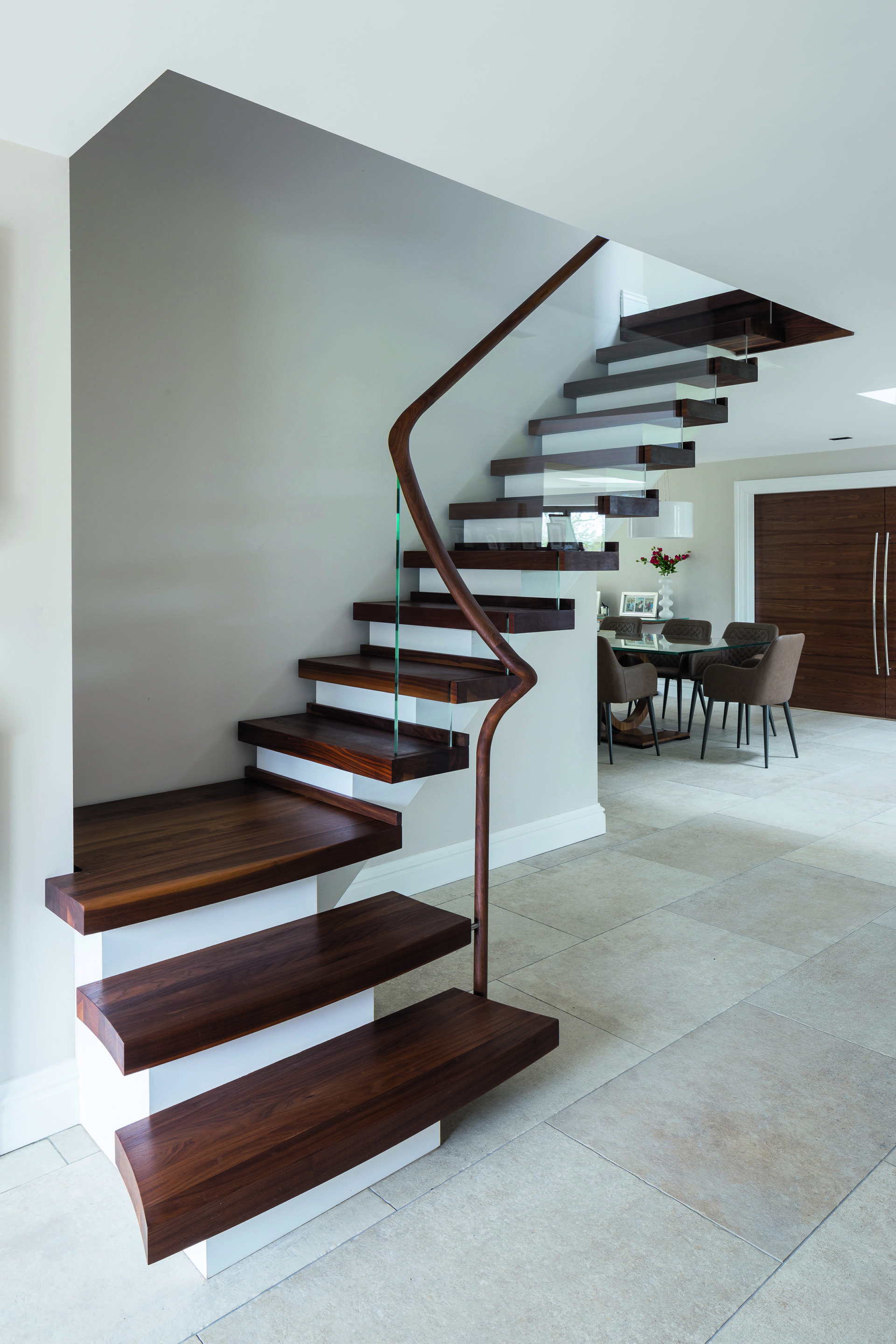
The soffit has a gentle curve, finishing up to the wall, with a similarly twisted handrail. There is a small gap detail to allow for feature lighting at the side of the treads.
Digitally designed and laser cut by the Facit Homes studio as part of a full house build, this staircase appears cantilevered and structurally supported by the wall, but actually rests subtly on the floor.
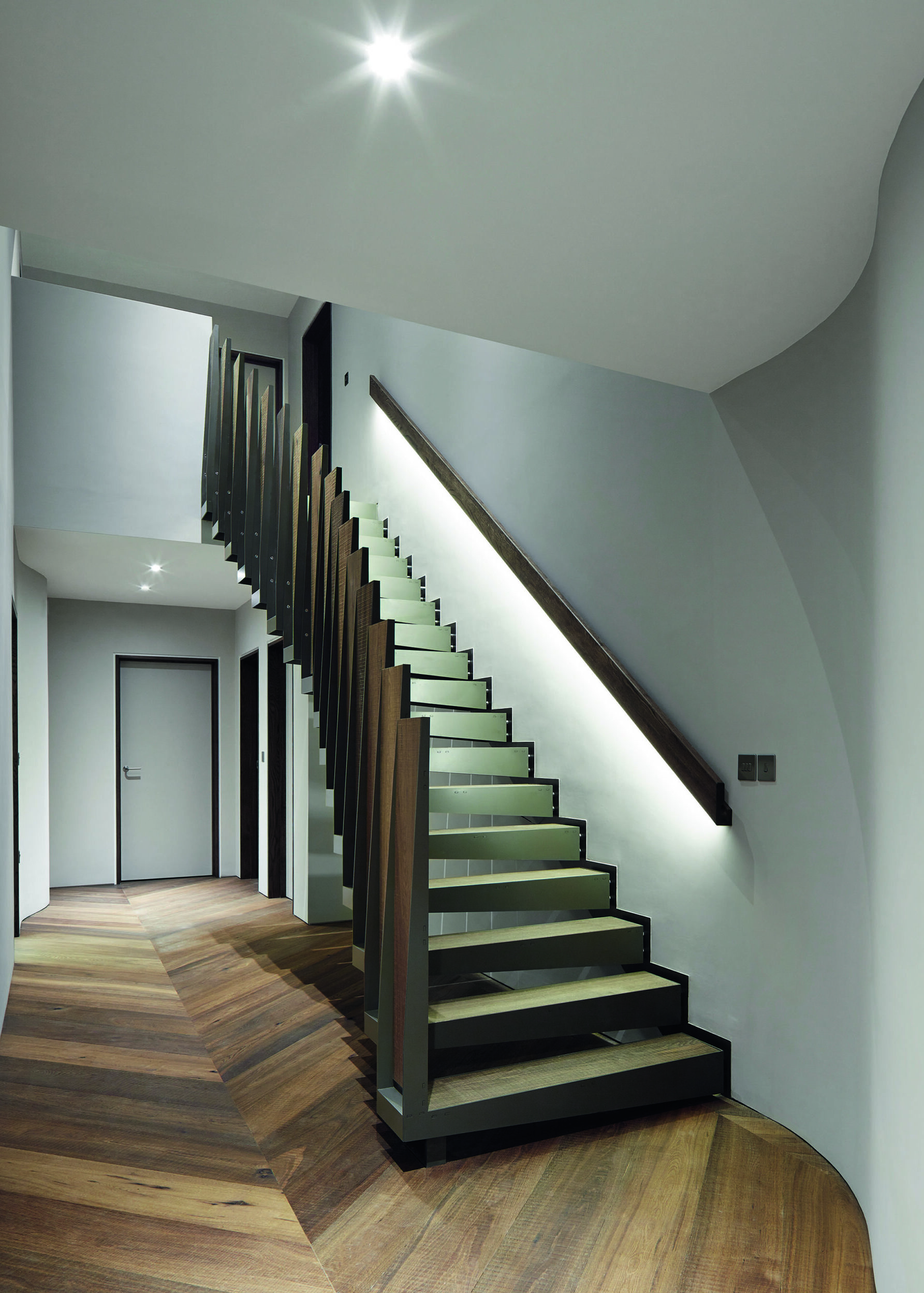
A parametric design means that each component steps in as the stair rises, accentuating the deceptive effect. Downlights on the balustrade add to the illusion
Consisting of a central metal spine supporting solid wooden treads and a glass balustrade, this staircase from Max-Stairs embodies modern simplicity.
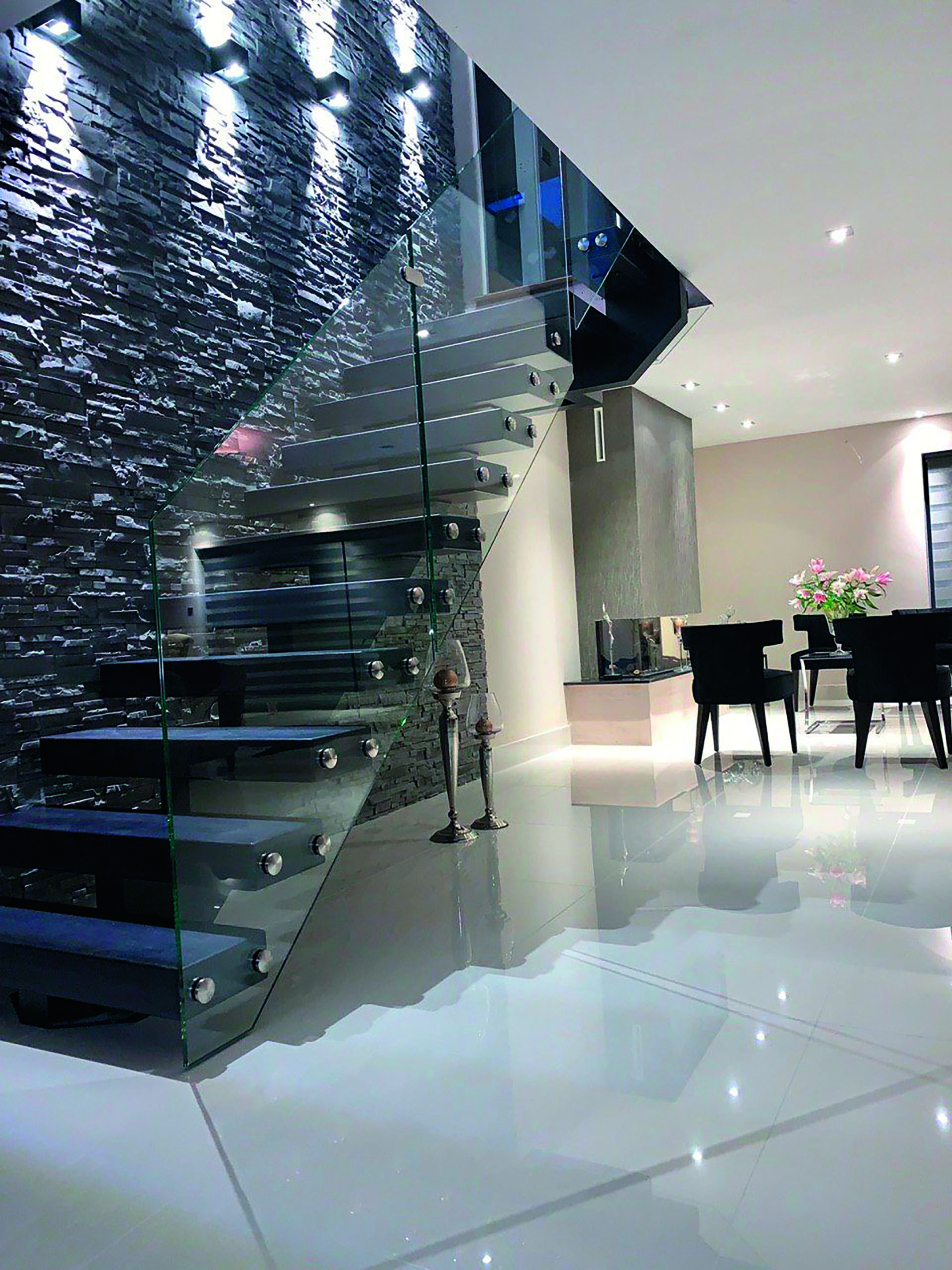
The chunky steps are sized to reduce the gap between treads to less than 100mm, complying with the UK standard.
It’s important to get a specialist on board as early as possible. For a renovation, ideally as soon as the project is specified, as the structure will have a large impact on all aspects of design when modernising or updating the interior. A specialist will bring a fresh perspective and valuable experience to the project to help you choose between the options and design details on offer.
For a self build, it is wise to involve an expert from the planning stages, before anything physical or structural is agreed. It’s quite common, however, for the details to be considered later in the process and for a client to make contact once the architectural designs have been confirmed. In this case, a bespoke staircase designer, like Bisca, will have the experience to work with existing configurations and maximise the space’s potential.
The scale of the house and integral features, such as the ceiling height and window size, are important factors. It’s key to ensure the staircase fits proportionately within the overall space and is not either too overpowering or too underwhelming; but more so it offers a balance between its prominence and other attractive features in the building.
Experienced design engineers will tell you form always follows function. And so, a staircase’s functional purpose is the first important consideration when looking at where it will be situated. How will people move around your home and how does light travel from one space to another? Are you after a statement staircase within a central area or hallway, where its aesthetics can enhance the interior design scheme; or is there a view you want to capture?
Ultimately, the placement of a staircase should optimise comfort in every respect. Considering the size of the rise of each tread will determine its direction and how it’s attached to the building. Some spaces are more compact and therefore impose limitations on where a staircase can be placed. In these circumstances, a creative mindset is needed, looking at different layouts and styles.
There are various practical regulations that must legally be followed throughout the initial design, manufacture and installation stages of a staircase project. In our 30 years of experience, one of our first considerations when it comes to safety and Building Regulations would be the height and design of a balustrade. While legislation guides us, our specialist knowledge means we know where there is flexibility in what can be achieved; helping us maximise comfort without infringing on essential safety criteria.
We will consider the characteristics of the property and style of the staircase; a multi-flight structure, for example, often demands a slightly raised balustrade in comparison to a smaller, more compact design. The finish of the staircase tread is also critical to its safety – tiles are all-the-rage, however they are not so practical underfoot. Many hard surfaces can be treated to create a degree of friction, so selecting timber, glass or stone with a grain or textured effect can minimise potential tripping hazards.
It’s important to avoid ‘pocket catchers’ in your design, too, as the angles at which you access or travel up/down a staircase can vary significantly.
Timber is a hugely versatile material, but it’s also extremely compatibility with other materials. We prefer not to exceed using more than three materials in one design – although sometimes less is more and we’ll work with just one or two.
Glass brings a modern touch to any staircase and can be combined with both aged or contemporary timber finishes. What sets glass apart as a material is how it can connect with the main staircase structure. While using invisible fixings requires exacting precision from an engineering perspective, in return this level of detail will reward with a sense of elegance which is hard to replicate with other materials.
Metal spindles, including forged uprights, will add character to a timber staircase and come in many forms, shapes and finishes. When a staircase is truly bespoke, each element will be hand-crafted, and so putting thought into how each upright will interface with its tread to form a clean and crisp junction is essential.
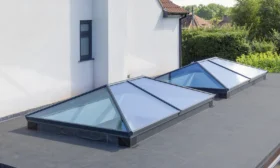
Comments are closed.